Nearest Store
- (907) 202-7405
- Get Directions
- Store Details
Mon-Fri: 8:00 AM - 6:00 PM
Sat: 8:00 AM - 5:00 PM

Find Another Store
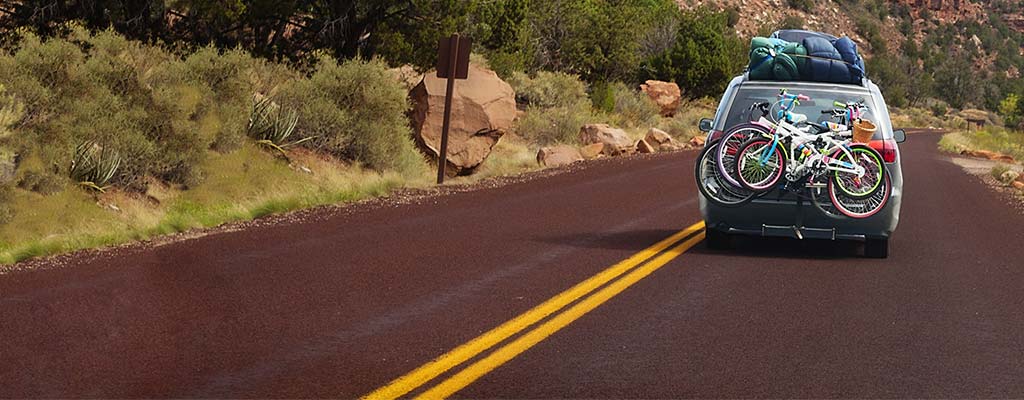
Pre-Trip Safety Check*
A freebie that could save you more than money.
Before you head out on a road trip, schedule your free Pre-Trip Safety Check. Our pros will inspect your vehicle and send you on your way.
- (907) 202-7405
Safety Checks Done Right
- Schedule Your Free Pre-Trip Safety Check
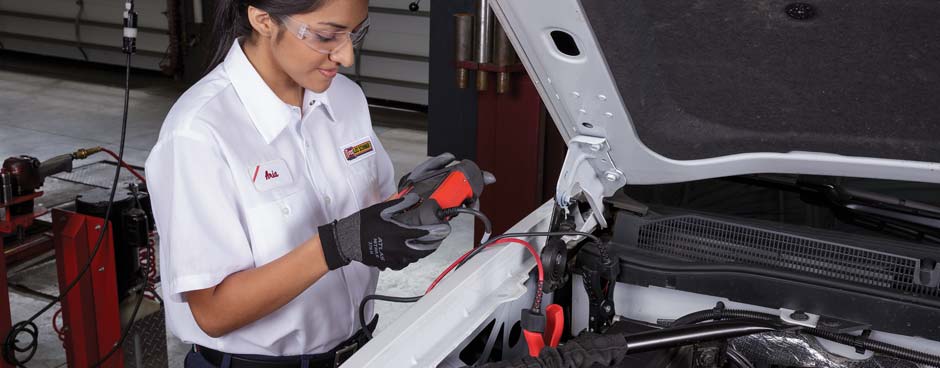
When it comes to safety, the pros at Les Schwab know a thing or two about the services your vehicle needs for safety and performance. Our free Pre-Trip Safety Check goes beyond your tires and wheels with visual inspections of your steering, battery, brakes, suspension, and alignment.
Checking Your Tires and Wheels
Inspecting your wheels and tires for leaks, tread wear, and balance to keep you rolling the right way.
Aligning with Your Schedule
Potholes, curbs, and more can knock your vehicle out of alignment, reducing fuel efficiency and wearing out your tires a lot faster.
Keeping You in Contact with the Road
When your shocks and struts are working properly, they keep your tires in contact with the road. That connection adds up to safety and comfort.
Take Charge of Your Battery
If your battery isn’t running at peak capacity, neither will your vehicle, which could leave you stranded.
SCHEDULE YOUR FREE PRE-TRIP SAFETY CHECK
The Les Schwab free Pre-Trip Safety Check includes a long list of visual inspections. Once our pros are done checking out your vehicle, they’ll give you their honest advice and show you all of your options. If your car or truck doesn't have any issues, they’ll send you on your way — free of charge.
Services Include:
- Tire Inspection
- Tire Pressure Check
- Visual Wheel Alignment Inspection as Indicated by Tire Wear
- Visual Inspection of Front End Components
- Visual Inspection of Shocks and/or Struts
- Visual Battery Inspection and Load Test
- Visual Inspection of Brake Components, Including:
- Brake Rotors and Drums
- Brake Pads and Shoes (Including Braking Material Measurement Using a Brake Gauge)
- Brake Hose and Hardware
- Master Cylinder Including a Check of Your Brake Fluid
* Most Vehicles
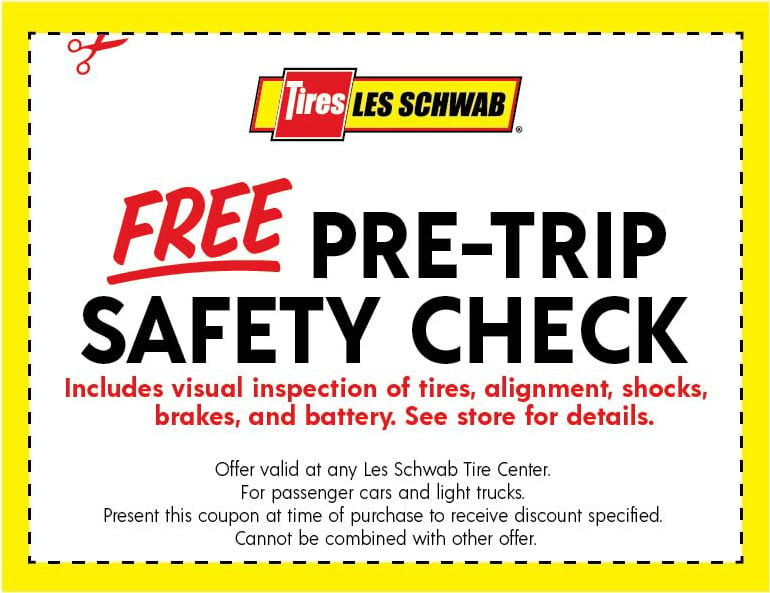
What You Need To Know
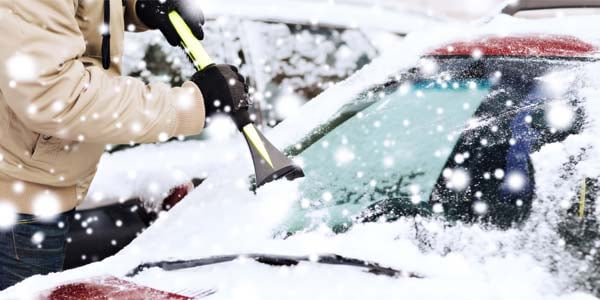
Winter Driving Tips: Top Safety Reminders
Be ready to drive in any winter weather by following these tips.
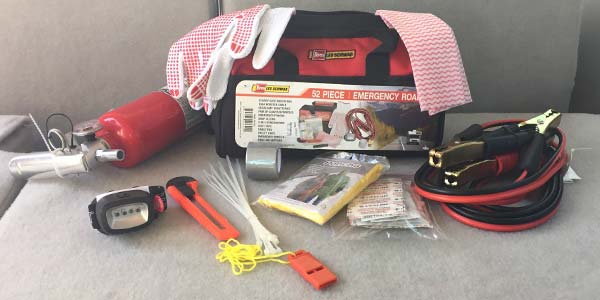
Be a Hero with a Summer Road Trip Safety Kit
Keeping a simple summer road trip safety kit in your vehicle during the warm months will make your travel more carefree — and you just might save the day.
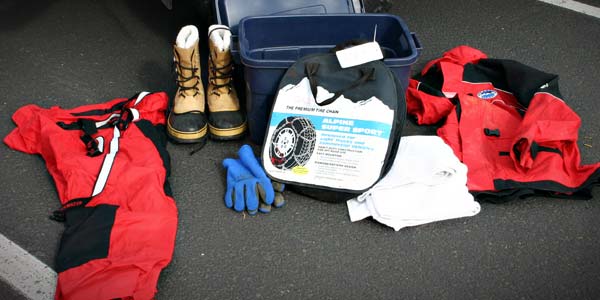
14 Items to Put in Your Winter Road Trip Safety Kit
Now’s the time to get road-ready for the snowy months with a winter road trip safety kit. Here’s what should be in it.
Pre-Trip Inspections: Know Before You Go

You leave your truck for the night and return the next morning. In between, anything could happen. How do you know your vehicle is still in tip-top shape? You won’t unless you conduct a thorough pre-trip inspection.
The Federal Motor Carrier Safety Administration (FMCSA) requires pre-trip inspections every time you start a shift. If you’re running late or in a hurry, it’s tempting to skip the inspection or cut corners. But if you’re not careful, you could suffer a breakdown or blowout, damage your truck and harm yourself and others on the road.
Set aside between 15 and 30 minutes for a proper inspection, and don’t rush through it. Try to follow the same sequence every time so you don’t miss any steps. Avoid common vehicle out-of-service violations and protect your truck with these extra tips:
Light all lamps. Look for burnt-out headlight bulbs, both on low-beam and high-beam. Check all other lights, including brake lights. Make sure your turn signals work properly. Fasten any loose light covers. Verify all reflectors are on the truck and trailer in the proper places.
Evaluate your braking system. Adjust brakes properly. Ensure brake hoses and lines are securely mounted and free from any cuts, frays or damage.
Inspect every tire. Tires wear differently depending on their position, so scrutinize all of them. Look for any cuts, damages or bulges. Maintain a tread depth of at least 4/32-inch. Measure tire pressure with a gauge (not a tire thumper) and maintain 90 – 100 psi. Tighten any loose lug nuts and report any missing ones. Listen for any air leaks.
Look underneath and inside your trailer. Check for signs of debris and even people—we’ve heard reports of drivers finding people sleeping under their truck or inside their truck. Remove any tree limbs or other objects from your path. Confirm your landing gear is fully raised.
Examine the fifth wheel. Make sure no gaps exist between the fifth wheel and the trailer apron. Inspect the kingpin and locking jaws.
Peek under the hood. Check your oil, coolant, transmission, wiper and power steering fluids and fill if needed. Inspect power steering hoses for any cracks or damage.
Don’t forget your emergency kit. Pack flares, triangles and other safety devices. Make sure your fire extinguisher is charged and secured—this is a common vehicle out-of-service violation.
Get comfortable in the cab . Adjust your driver’s seat and all mirrors before you start your truck.
Document any defects. Fill out a Driver Vehicle Inspection Report (DVIR) whenever you spot any broken or missing parts so your motor carrier can repair your vehicle quickly.
Download and share a PDF of this Safety Bulletin with your drivers.
English Español Français

At this time the Penske website requires that you enable JavaScript in order to take advantage of our website features. Please enable JavaScript and retry.
For assistance with other Penske services, please use the numbers below.
Truck Rental
- Household Rentals: 1-800-GO-PENSKE
- Business Rentals: 1-844-906-3404
Used Trucks
- 1-866-309-1962
Truck Leasing
- 1-888-234-4201
Penske Logistics
- 1-800-529-6531
- How it works
- For business
Set Location
How Much Does a Car Inspection Cost?
You received notice that your car must undergo an inspection, but how much does a car inspection cost? Check out all the details below to help you budget.
The average car safety, emissions, or VIN dropdown#toggle" data-dropdown-placement-param="top" data-term-id="287592968"> dropdown#toggle" data-dropdown-menu-id-param="menu_term_287592968" data-dropdown-placement-param="top" data-term-id="287592968">inspection costs less than $100, with most dropdown#toggle" data-dropdown-placement-param="top" data-term-id="287593012"> dropdown#toggle" data-dropdown-menu-id-param="menu_term_287593012" data-dropdown-placement-param="top" data-term-id="287593012">pre-purchase inspections costing between $150 and $250.
Depending on local laws, many drivers must submit their vehicles to one or more inspections annually or biannually. Each set of inspection requirements also includes various exceptions and associated fees, making untangling the web of dropdown#toggle" data-dropdown-placement-param="top" data-term-id="287592967"> dropdown#toggle" data-dropdown-menu-id-param="menu_term_287592967" data-dropdown-placement-param="top" data-term-id="287592967">car inspections a challenging task for most people.
When you subscribe to a FINN vehicle, you won’t even have to worry about dropdown#toggle" data-dropdown-placement-param="top" data-term-id="287592967"> dropdown#toggle" data-dropdown-menu-id-param="menu_term_287592967" data-dropdown-placement-param="top" data-term-id="287592967">car inspections . FINN vehicles come with a general inspection included, so you can rest easy that the car that pulls into your drive is road-worthy, insured, and well-maintained. Your monthly subscription fee includes these services in addition to deprecation and registration. All that’s left to do is enjoy the open road before you and your next adventure.
What is a car inspection?
A dropdown#toggle" data-dropdown-placement-param="top" data-term-id="287592967"> dropdown#toggle" data-dropdown-menu-id-param="menu_term_287592967" data-dropdown-placement-param="top" data-term-id="287592967">car inspection verifies your vehicle is safe, emission-compliant, and legally obtained. States require various types of inspections to protect the safety of other drivers on the road, reduce car accidents, and drive revenue. If you’re pulled over and cited for an issue with your vehicle’s safety, you may have to pass an inspection before legally driving that vehicle again.
Each state, city, and county sets forth its own requirements for dropdown#toggle" data-dropdown-placement-param="top" data-term-id="287592966"> dropdown#toggle" data-dropdown-menu-id-param="menu_term_287592966" data-dropdown-placement-param="top" data-term-id="287592966">vehicle inspections . Car insurance carriers may also require inspections before granting vehicle coverage. When you arrive for an inspection, you may be asked to provide several documents, including your driver’s license, proof of insurance, the vehicle’s title , or a bill of sale. If you fail an inspection, you may be granted a second attempt, pay a fine, or face having to park the car until you can resolve the issue.
Who performs dropdown#toggle" data-dropdown-placement-param="top" data-term-id="287592967"> dropdown#toggle" data-dropdown-menu-id-param="menu_term_287592967" data-dropdown-placement-param="top" data-term-id="287592967">car inspections ?
Government-run testing facilities perform the majority of safety, VIN, and emissions dropdown#toggle" data-dropdown-placement-param="top" data-term-id="287592967"> dropdown#toggle" data-dropdown-menu-id-param="menu_term_287592967" data-dropdown-placement-param="top" data-term-id="287592967">car inspections . However, many certified private-run testing facilities may also perform inspections to reduce the burden on government-run facilities. dropdown#toggle" data-dropdown-placement-param="top" data-term-id="287592981"> dropdown#toggle" data-dropdown-menu-id-param="menu_term_287592981" data-dropdown-placement-param="top" data-term-id="287592981">Dealerships and local mechanic shops typically perform dropdown#toggle" data-dropdown-placement-param="top" data-term-id="287593012"> dropdown#toggle" data-dropdown-menu-id-param="menu_term_287593012" data-dropdown-placement-param="top" data-term-id="287593012">pre-purchase inspections .
Where to get a car inspection?
Knowing where to go to get a dropdown#toggle" data-dropdown-placement-param="top" data-term-id="287592967"> dropdown#toggle" data-dropdown-menu-id-param="menu_term_287592967" data-dropdown-placement-param="top" data-term-id="287592967">car inspection first requires figuring out what type of inspection you need (see more details below). However, most inspections are done at the following:
- Government facilities: Safety, emissions, and VIN testing are housed under one roof at a government-run facility. In many states, you’ll need official documentation that your vehicle passed these inspections before you can legally register the car.
- dropdown#toggle" data-dropdown-placement-param="top" data-term-id="287592981"> dropdown#toggle" data-dropdown-menu-id-param="menu_term_287592981" data-dropdown-placement-param="top" data-term-id="287592981">Dealerships : When you’re deciding whether to buy a new or dropdown#toggle" data-dropdown-placement-param="top" data-term-id="287592973"> dropdown#toggle" data-dropdown-menu-id-param="menu_term_287592973" data-dropdown-placement-param="top" data-term-id="287592973">used car , it’s common to see dropdown#toggle" data-dropdown-placement-param="top" data-term-id="287592981"> dropdown#toggle" data-dropdown-menu-id-param="menu_term_287592981" data-dropdown-placement-param="top" data-term-id="287592981">dealerships advertise their in-depth inspections with a myriad of inspection points. While these inspections do concern the safety and emissions equipment on a vehicle, they’re more along the lines of a dropdown#toggle" data-dropdown-placement-param="top" data-term-id="287593012"> dropdown#toggle" data-dropdown-menu-id-param="menu_term_287593012" data-dropdown-placement-param="top" data-term-id="287593012">pre-purchase inspection (PPI).
- Local mechanic or dropdown#toggle" data-dropdown-placement-param="top" data-term-id="287592979"> dropdown#toggle" data-dropdown-menu-id-param="menu_term_287592979" data-dropdown-placement-param="top" data-term-id="287592979">auto dropdown#toggle" data-dropdown-placement-param="top" data-term-id="287592991"> dropdown#toggle" data-dropdown-menu-id-param="menu_term_287592991" data-dropdown-placement-param="top" data-term-id="287592991"> dropdown#toggle" data-dropdown-menu-id-param="menu_term_287592979" data-dropdown-placement-param="top" data-term-id="287592979"> dropdown#toggle" data-dropdown-placement-param="top" data-term-id="287592979">repair dropdown#toggle" data-dropdown-menu-id-param="menu_term_287592991" data-dropdown-placement-param="top" data-term-id="287592991"> dropdown#toggle" data-dropdown-placement-param="top" data-term-id="287592991"> shops : Similar to dropdown#toggle" data-dropdown-placement-param="top" data-term-id="287592981"> dropdown#toggle" data-dropdown-menu-id-param="menu_term_287592981" data-dropdown-placement-param="top" data-term-id="287592981">dealerships , local dropdown#toggle" data-dropdown-placement-param="top" data-term-id="287592997"> dropdown#toggle" data-dropdown-menu-id-param="menu_term_287592997" data-dropdown-placement-param="top" data-term-id="287592997">car dropdown#toggle" data-dropdown-placement-param="top" data-term-id="287592991"> dropdown#toggle" data-dropdown-menu-id-param="menu_term_287592991" data-dropdown-placement-param="top" data-term-id="287592991"> dropdown#toggle" data-dropdown-menu-id-param="menu_term_287592997" data-dropdown-placement-param="top" data-term-id="287592997"> dropdown#toggle" data-dropdown-placement-param="top" data-term-id="287592997">repair dropdown#toggle" data-dropdown-menu-id-param="menu_term_287592991" data-dropdown-placement-param="top" data-term-id="287592991"> dropdown#toggle" data-dropdown-placement-param="top" data-term-id="287592991"> shops often perform PPIs for customers. Some may also be certified inspection facilities recognized by the local government and authorized to pass or fail vehicles during an inspection.
- Mobile dropdown#toggle" data-dropdown-placement-param="top" data-term-id="287592986"> dropdown#toggle" data-dropdown-menu-id-param="menu_term_287592986" data-dropdown-placement-param="top" data-term-id="287592986">inspection services : These mechanic shops-on-wheels mirror authorized mechanic shops that can pass or fail a vehicle during an inspection. While these services may cost more due to their convenience, the extra fee can be worth avoiding the hassle.
- Certified dropdown#toggle" data-dropdown-placement-param="top" data-term-id="287592974"> dropdown#toggle" data-dropdown-menu-id-param="menu_term_287592974" data-dropdown-placement-param="top" data-term-id="287592974">inspection stations : Privately held or government-run, these stations are recognized by the local authorities to perform safety, emissions, and VIN inspections.
If you’re unsure where to get an inspection, a quick internet search can help point you in the right direction. Calling a facility to confirm they perform the inspection you need can also help save you time, as they may be able to refer you to the correct facility if they don’t perform that particular type of inspection.
How much do car inspections cost?
Most state car safety and dropdown#toggle" data-dropdown-placement-param="top" data-term-id="287592971"> dropdown#toggle" data-dropdown-menu-id-param="menu_term_287592971" data-dropdown-placement-param="top" data-term-id="287592971">emissions inspections nationwide cost under $100 if you opt for a government-run testing facility. Certified or approved third-party shops often charge more but may offer an expedited service. You can usually find the cost of dropdown#toggle" data-dropdown-placement-param="top" data-term-id="287592966"> dropdown#toggle" data-dropdown-menu-id-param="menu_term_287592966" data-dropdown-placement-param="top" data-term-id="287592966">vehicle inspections listed on your city or county’s Department of dropdown#toggle" data-dropdown-placement-param="top" data-term-id="287592995"> dropdown#toggle" data-dropdown-menu-id-param="menu_term_287592995" data-dropdown-placement-param="top" data-term-id="287592995">Motor Vehicles ( dropdown#toggle" data-dropdown-placement-param="top" data-term-id="287593004"> dropdown#toggle" data-dropdown-menu-id-param="menu_term_287593004" data-dropdown-placement-param="top" data-term-id="287593004">DMV ) website, with a breakdown of specific fees that may apply.
VIN dropdown#toggle" data-dropdown-placement-param="top" data-term-id="287592968"> dropdown#toggle" data-dropdown-menu-id-param="menu_term_287592968" data-dropdown-placement-param="top" data-term-id="287592968">inspection costs vary by state, city, and county but typically don’t exceed $100. dropdown#toggle" data-dropdown-placement-param="top" data-term-id="287593012"> dropdown#toggle" data-dropdown-menu-id-param="menu_term_287593012" data-dropdown-placement-param="top" data-term-id="287593012">Pre-purchase inspections can cost between $150 and $250, depending on which facility performs the testing and its specific inspection procedures. Buyers and sellers often make arrangements to pay half of the dropdown#toggle" data-dropdown-placement-param="top" data-term-id="287592968"> dropdown#toggle" data-dropdown-menu-id-param="menu_term_287592968" data-dropdown-placement-param="top" data-term-id="287592968">inspection cost each, reducing the dropdown#toggle" data-dropdown-placement-param="top" data-term-id="287592968"> dropdown#toggle" data-dropdown-menu-id-param="menu_term_287592968" data-dropdown-placement-param="top" data-term-id="287592968">inspection cost to $75 and $125 per person. However, the seller may place the burden of paying for the inspection fully on the buyer, a price that may be well worth the trouble if the inspection brings to light an issue that could jeopardize the sale.
Types of car inspections
There are four main types of dropdown#toggle" data-dropdown-placement-param="top" data-term-id="287592967"> dropdown#toggle" data-dropdown-menu-id-param="menu_term_287592967" data-dropdown-placement-param="top" data-term-id="287592967">car inspections :
- dropdown#toggle" data-dropdown-placement-param="top" data-term-id="287592970"> dropdown#toggle" data-dropdown-menu-id-param="menu_term_287592970" data-dropdown-placement-param="top" data-term-id="287592970">Safety inspection : This type of dropdown#toggle" data-dropdown-placement-param="top" data-term-id="287592983"> dropdown#toggle" data-dropdown-menu-id-param="menu_term_287592983" data-dropdown-placement-param="top" data-term-id="287592983">annual inspection includes testing safety equipment, such as headlights, turn signals, brake lights, and backup cameras. Testers may also inspect the car’s windshield, tires, and other components related to the vehicle’s safety measures.
- dropdown#toggle" data-dropdown-placement-param="top" data-term-id="287592971"> dropdown#toggle" data-dropdown-menu-id-param="menu_term_287592971" data-dropdown-placement-param="top" data-term-id="287592971">Emissions inspection : Otherwise known as dropdown#toggle" data-dropdown-placement-param="top" data-term-id="287593000"> dropdown#toggle" data-dropdown-menu-id-param="menu_term_287593000" data-dropdown-placement-param="top" data-term-id="287593000">smog testing, an dropdown#toggle" data-dropdown-placement-param="top" data-term-id="287592969"> dropdown#toggle" data-dropdown-menu-id-param="menu_term_287592969" data-dropdown-placement-param="top" data-term-id="287592969">emissions test includes measuring how efficiently the car’s emissions and dropdown#toggle" data-dropdown-placement-param="top" data-term-id="287592982"> dropdown#toggle" data-dropdown-menu-id-param="menu_term_287592982" data-dropdown-placement-param="top" data-term-id="287592982">exhaust system works. Vehicles must perform at various speeds to ensure the emission components respond adequately.
- VIN inspection: Criminals often commit fraud by moving vehicles across state lines, so a VIN inspection can help reduce this type of fraud with mandatory screenings. Inspectors will ensure the VIN displayed across various body panels and the title matches in this dropdown#toggle" data-dropdown-placement-param="top" data-term-id="287592976"> dropdown#toggle" data-dropdown-menu-id-param="menu_term_287592976" data-dropdown-placement-param="top" data-term-id="287592976">state inspection .
- dropdown#toggle" data-dropdown-placement-param="top" data-term-id="287593012"> dropdown#toggle" data-dropdown-menu-id-param="menu_term_287593012" data-dropdown-placement-param="top" data-term-id="287593012">Pre-purchase inspection (PPI): A PPI inspects significant vehicle components, including the powertrain, dropdown#toggle" data-dropdown-placement-param="top" data-term-id="287592987"> dropdown#toggle" data-dropdown-menu-id-param="menu_term_287592987" data-dropdown-placement-param="top" data-term-id="287592987">brake system , tires, dropdown#toggle" data-dropdown-placement-param="top" data-term-id="287593006"> dropdown#toggle" data-dropdown-menu-id-param="menu_term_287593006" data-dropdown-placement-param="top" data-term-id="287593006">fluid levels , hoses, belts, and more. Mechanic shops that offer PPIs often list the inspected components for your reference. dropdown#toggle" data-dropdown-placement-param="top" data-term-id="287593011"> dropdown#toggle" data-dropdown-menu-id-param="menu_term_287593011" data-dropdown-placement-param="top" data-term-id="287593011">Car owners may opt to perform an dropdown#toggle" data-dropdown-placement-param="top" data-term-id="287593014"> dropdown#toggle" data-dropdown-menu-id-param="menu_term_287593014" data-dropdown-placement-param="top" data-term-id="287593014">annual dropdown#toggle" data-dropdown-placement-param="top" data-term-id="287592970"> dropdown#toggle" data-dropdown-menu-id-param="menu_term_287592970" data-dropdown-placement-param="top" data-term-id="287592970"> dropdown#toggle" data-dropdown-menu-id-param="menu_term_287593014" data-dropdown-placement-param="top" data-term-id="287593014"> dropdown#toggle" data-dropdown-placement-param="top" data-term-id="287593014">safety dropdown#toggle" data-dropdown-menu-id-param="menu_term_287592970" data-dropdown-placement-param="top" data-term-id="287592970"> dropdown#toggle" data-dropdown-placement-param="top" data-term-id="287592970"> inspection , especially before inclement weather hits, to gain dropdown#toggle" data-dropdown-placement-param="top" data-term-id="287592990"> dropdown#toggle" data-dropdown-menu-id-param="menu_term_287592990" data-dropdown-placement-param="top" data-term-id="287592990">peace of mind .
Most, if not all, roadworthy vehicles must pass a safety and dropdown#toggle" data-dropdown-placement-param="top" data-term-id="287592971"> dropdown#toggle" data-dropdown-menu-id-param="menu_term_287592971" data-dropdown-placement-param="top" data-term-id="287592971">emissions inspection at one point. While VIN inspections and PPIs are less common, they can be done multiple times during a car’s life. When you buy a brand- dropdown#toggle" data-dropdown-placement-param="top" data-term-id="287592977"> dropdown#toggle" data-dropdown-menu-id-param="menu_term_287592977" data-dropdown-placement-param="top" data-term-id="287592977">new car , it will typically include an dropdown#toggle" data-dropdown-placement-param="top" data-term-id="287592985"> dropdown#toggle" data-dropdown-menu-id-param="menu_term_287592985" data-dropdown-placement-param="top" data-term-id="287592985">inspection sticker that exempts it from certain testing until a specified date.
When to get a car inspection?
Savvy dropdown#toggle" data-dropdown-placement-param="top" data-term-id="287592973"> dropdown#toggle" data-dropdown-menu-id-param="menu_term_287592973" data-dropdown-placement-param="top" data-term-id="287592973">used car buyers typically perform PPIs before purchasing a car. However, local laws often dictate the frequency of safety, emissions, and VIN inspections. For example, Arkansas and Alaska don’t have dropdown#toggle" data-dropdown-placement-param="top" data-term-id="287592966"> dropdown#toggle" data-dropdown-menu-id-param="menu_term_287592966" data-dropdown-placement-param="top" data-term-id="287592966">vehicle inspection requirements, but Colorado requires all three when a vehicle changes hands. Should you need one or more inspections before registering or insuring your car, the specific entity requesting that inspection will notify you beforehand.
Many people focus on what credit score is needed to buy a car , but knowing what documentation you need to register a vehicle can be even more critical. If you receive notice that your car must undergo inspection, research where and how you can schedule your vehicle. You can also contact the company or department that sent you the notice to learn more about what’s required of you.
Do you need to have your car inspected before purchasing auto insurance?
Car insurance carriers often fall into one of two categories: those that require an inspection before issuing coverage and those that only perform an inspection after a claim has been filed. State laws and individual insurance company policies dictate when an inspection occurs. Auto insurance carriers often perform inspections to reduce the cost of car insurance, prevent fraud, and ensure the safety of all drivers and their passengers.
What are vehicle inspection requirements by state?
When you’ve gone from asking yourself if you need a truck to what dropdown#toggle" data-dropdown-placement-param="top" data-term-id="287592966"> dropdown#toggle" data-dropdown-menu-id-param="menu_term_287592966" data-dropdown-placement-param="top" data-term-id="287592966">vehicle inspection requirements your state has, check out the following list of requirements per state:
Visit your state’s Department of dropdown#toggle" data-dropdown-placement-param="top" data-term-id="287592995"> dropdown#toggle" data-dropdown-menu-id-param="menu_term_287592995" data-dropdown-placement-param="top" data-term-id="287592995">Motor Vehicles ( dropdown#toggle" data-dropdown-placement-param="top" data-term-id="287593004"> dropdown#toggle" data-dropdown-menu-id-param="menu_term_287593004" data-dropdown-placement-param="top" data-term-id="287593004">DMV ) website to keep up with the latest dropdown#toggle" data-dropdown-placement-param="top" data-term-id="287592966"> dropdown#toggle" data-dropdown-menu-id-param="menu_term_287592966" data-dropdown-placement-param="top" data-term-id="287592966">vehicle inspection requirements.
Final thoughts
Car inspections go hand-in-hand with owning a vehicle, but sometimes, various inspection requirements can have your head spinning. Paying for the inspections can also put a wrench in your plans if you’re unsure how much to budget, where to go, and what type of inspection you need. It can take a few years of struggling through inspection notices to figure out how the system works.
Looking for a hack to avoid the long lines for car inspections ? FINN car subscriptions incorporate a general inspection, while maintenance, insurance, depreciation, and registration all come with your monthly subscription fee. Subscribe to a FINN vehicle to see the difference and simplify car ownership to get you back on the road without the hassles of car inspections . Your new ride and your next adventure await.
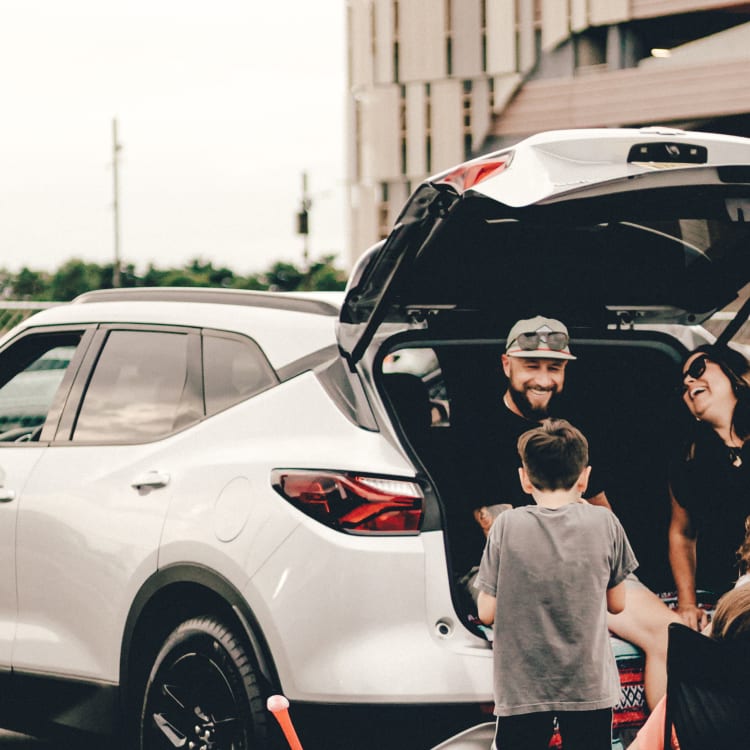
You may also like

How to Pay Off a Car Loan Faster
Figuring out how to pay off a car loan faster requires math and critical thinking. Read on to see how to pay off your car loan quickly to get out of debt.

How Long Can You Get a Car Loan For? Things to Consider Before Applying
Depending on the bank, you can get a car loan for up to 96 months. However, there are some steps to consider before applying for a long-term loan. In this article, we break down how financing a car works.

Can You Sell a Car Without Registration?
Is it possible to sell a used car without registration? Learn about the process and the pros and cons.
- PRO Courses Guides New Tech Help Pro Expert Videos About wikiHow Pro Upgrade Sign In
- EDIT Edit this Article
- EXPLORE Tech Help Pro About Us Random Article Quizzes Request a New Article Community Dashboard This Or That Game Popular Categories Arts and Entertainment Artwork Books Movies Computers and Electronics Computers Phone Skills Technology Hacks Health Men's Health Mental Health Women's Health Relationships Dating Love Relationship Issues Hobbies and Crafts Crafts Drawing Games Education & Communication Communication Skills Personal Development Studying Personal Care and Style Fashion Hair Care Personal Hygiene Youth Personal Care School Stuff Dating All Categories Arts and Entertainment Finance and Business Home and Garden Relationship Quizzes Cars & Other Vehicles Food and Entertaining Personal Care and Style Sports and Fitness Computers and Electronics Health Pets and Animals Travel Education & Communication Hobbies and Crafts Philosophy and Religion Work World Family Life Holidays and Traditions Relationships Youth
- Browse Articles
- Learn Something New
- Quizzes Hot
- This Or That Game New
- Train Your Brain
- Explore More
- Support wikiHow
- About wikiHow
- Log in / Sign up
- Cars & Other Vehicles
- Car Maintenance and Repair
The Ultimate Car Maintenance Checklist For Road Trips
Last Updated: March 19, 2024 Approved
Inspecting Your Vehicle
- Addressing Issues
Preparing to Depart
Expert q&a.
This article was co-authored by Tom Eisenberg . Tom Eisenberg is the Owner and General Manager of West Coast Tires & Service in Los Angeles, California, a family-owned AAA-approved and certified auto shop. Tom has over 10 years of experience in the auto industry. Modern Tire Dealer Magazine voted his shop one of the Best 10 Operations in the Country. There are 8 references cited in this article, which can be found at the bottom of the page. wikiHow marks an article as reader-approved once it receives enough positive feedback. This article received 15 testimonials and 100% of readers who voted found it helpful, earning it our reader-approved status. This article has been viewed 479,306 times.
Planning on going on a road trip soon? Before you do so, you should check your car to make sure that it is in good condition and running well. If you spend a little time preparing your vehicle for the trip beforehand, you can avoid most problems that might ruin your fun along the way.
Quick Steps
- Check that your tires are inflated and the treads are deep enough for long travel.
- Inspect your exterior lights, horn, and windshield wiper blades.
- Make sure your air filter isn’t clogged and that the AC and heat are working.
- Look at the belts in the engine for signs of cracking or glazing (shiny spots).
- Top off your oil, transmission fluid, and other fluids that are running low.
- Check and replace the brake pads if necessary.
- Prepare and pack a roadside emergency kit before you leave.

Blown-out lights can be hazardous as other drivers around you won't be able to know what you intend to do while driving, such as take a turn or put on the brakes. Also, a broken light can get you pulled over, which may leave you with an expensive ticket to pay.

- Place the penny upside down in the groove of the tire and see how much of Lincoln’s head you can see. If you can see further down Lincoln’s head than his forehead, the tires need to be replaced.

- Most air boxes are held shut with clips. Remove them to open the box and look at the air filter.
- The filter should be free of debris and usually white. If it looks particularly dirty, replace it before closing the airbox up again.
Addressing Issues that May Arise

- Plug the scanner into the open plastic connector port beneath the dashboard on the driver’s side.
- If the scanner doesn’t provide an English description with the error code, you can find the corresponding description in a vehicle-specific repair manual or often on the manufacturer’s website.

- Oil that’s in good condition will be translucent and slightly yellow or even greenish in color.
- To change the oil, slide a container under the oil pan that can capture the draining oil, then unscrew the drain plug (bolt at the bottom of the oil pan). Once the oil has drained completely, replace the plug and remove the oil filter. Install a new oil filter and then add the correct type and amount of oil for your vehicle, based on the information in your owner's manual.

- Automatic transmission fluid is one of the most important ones to check before a long road trip. Use your vehicle’s owner’s manual to tell you where to find the dipstick, then check it like you would engine oil.
- Make sure your radiator is topped off as well by comparing its fill line to the lower limit line visible on the reservoir.

Try to avoid packing things over your spare tire or emergency kit if you can. Setting off with a clean and organized car can give you added peace of mind.

- Driving without the appropriate documentation can lead to fines or even having your car impounded.
- Keep those important documents somewhere you can easily access in case you get pulled over.

- It’s also a good idea to carry a first aid kit .
- You may want to tailor some emergency supplies to your family or time of year. For instance, you may want to carry cat litter to help on slippery roads during the winter.

- You can get most commercial oil change facilities to do all of this for you at a (semi) reasonable cost. Thanks Helpful 1 Not Helpful 0
- If you are driving into remote areas ALWAYS ensure you have plenty of fuel in your tank, plenty of bottled drinking water, and ensure that someone knows how long you expect to be gone. Thanks Helpful 1 Not Helpful 1

You Might Also Like

- ↑ Tom Eisenberg. Auto Technician. Expert Interview. 26 July 2019.
- ↑ https://www.popularmechanics.com/cars/a26200/car-road-trip/
- ↑ https://www.cnet.com/roadshow/news/how-to-prep-your-car-for-a-road-trip/
- ↑ https://www.familyhandyman.com/automotive/car-maintenance/serpentine-belt-how-to-check-for-wear/view-all/
- ↑ https://www.dmv.org/how-to-guides/pre-trip-maintenance.php
- ↑ https://www.familyhandyman.com/automotive/car-brakes/how-to-change-front-brake-pads/view-all/
- ↑ https://www.carproof.com/resource-centre/articles/preparing-your-vehicle-for-a-road-trip
- ↑ https://www.dmv.org/how-to-guides/emergency-kit.php
About This Article

To check your car before a road trip, start by looking over the car inside and out for any noticeable issues, like burnt out headlights, or worn windshield wipers. Make sure your tires are inflated to the pressure specified in the owner's manual, and check the tread on your tires using the penny test. Open the hood and turn on the car to make sure the serpentine and accessory belts are conditioned and tense. Before you hit the road, resolve any warning lights that appear on your dashboard to avoid issues during your trip. For tips on addressing problems as they arise and getting ready to leave, read on! Did this summary help you? Yes No
- Send fan mail to authors
Reader Success Stories
Dulce Ramon
Jul 14, 2017
Did this article help you?

Jun 8, 2017
Divya Prasher
Mar 4, 2017
May 19, 2018
Jul 17, 2018

Featured Articles

Trending Articles

Watch Articles

- Terms of Use
- Privacy Policy
- Do Not Sell or Share My Info
- Not Selling Info
Get all the best how-tos!
Sign up for wikiHow's weekly email newsletter
- Credit cards
- View all credit cards
- Banking guide
- Loans guide
- Insurance guide
- Personal finance
- View all personal finance
- Small business
- Small business guide
- View all taxes
You’re our first priority. Every time.
We believe everyone should be able to make financial decisions with confidence. And while our site doesn’t feature every company or financial product available on the market, we’re proud that the guidance we offer, the information we provide and the tools we create are objective, independent, straightforward — and free.
So how do we make money? Our partners compensate us. This may influence which products we review and write about (and where those products appear on the site), but it in no way affects our recommendations or advice, which are grounded in thousands of hours of research. Our partners cannot pay us to guarantee favorable reviews of their products or services. Here is a list of our partners .
How Much Does a Car Inspection Cost?

Many or all of the products featured here are from our partners who compensate us. This influences which products we write about and where and how the product appears on a page. However, this does not influence our evaluations. Our opinions are our own. Here is a list of our partners and here's how we make money .
Table of Contents
Types of car inspections
Safety inspection, emissions inspection, used-car inspection.
Car inspections are not only part of maintaining a car — in some states, they’re required for car registration. But they can also pop up when you’re looking to purchase a used car.
How much you’ll pay out-of-pocket for an inspection depends on the type you need, the state in which you live and the kind of car being inspected. While these inspections are not a large part of the total cost of car ownership , they can alert you to the big issues that are.
When budgeting for a car inspection, it’s important to understand the type of inspection you need.
A safety inspection looks at how well your car drives and whether it’s safe to operate on the roads. These are mandatory in some states, either annually or biannually.
Emissions testing measures how well your exhaust system is working to avoid unnecessary pollution. These are mandatory in 33 states, either annually or biannually.
A used-car inspection looks at the condition of a car you plan to purchase from a dealer or private party. An inspection is recommended but not mandatory.
Want to refinance your auto loan? See if you pre-qualify.
Just answer a few questions to get personalized results from our lending partners.
on NerdWallet
Not all states require safety inspections; states that do mandate them have their own requirements for what inspections evaluate and how often cars have to have them. Most inspections will check your car’s basic safety features to look for issues such as:
Tire problems, such as worn tread on primary and spare tires.
Brake wear and tear on brake pads and rotors, including brake fluid leaks.
Loose steering and alignment that can affect driving.
Damaged suspension, including shock absorbers.
Cracked or chipped windshield that can obstruct your view.
Dysfunctional seat belts that won’t operate properly during an accident.
If you're moving to a new state, check requirements for registering your vehicle to find out if you need a current car inspection.
Cost of safety inspections
If your state requires a safety inspection, you should plan to spend from $10-$50, on average. There are several factors that can affect the total cost of a safety inspection.
State price limits
The cost to have your car inspected varies by state. Delaware provides inspections for free. Most states that require safety inspections set a limit on how much inspectors can charge. In those few states that leave it up to individual shops to set prices, a safety inspection usually doesn’t cost more than around $50.
Where you get it inspected
Depending on your state, you might have the option of going to a state-run facility or using a private shop with trained technicians. These options might charge different rates in states where the prices are not mandated.
The type of vehicle
An inspection for a new vehicle, motorcycle, moped or trailer might cost less than one for a standard used car. The actual price difference will depend on state regulations.
The age of the car
Inspections for new cars are likely to cost less within the first few years because a new car is unlikely to have developed any issues in that time. For example, Texas discounts the cost of safety inspections for cars that are 2 years old or newer from $25.50 to $7.
Some states will also adjust inspection prices for vehicles that were made before a certain year. While North Carolina exempts vehicles over 30 years old from annual safety inspections, Texas offers a discount for vehicles that are over 25 years old.

See what you could save on car insurance
Some states offer inspection exemptions based on car designations such as classic, vintage or antique. Check your state’s requirements to see if your vehicle qualifies.
Some states require emissions testing, also known as smog checks, to measure pollutants in a car’s exhaust. An emissions test looks at two aspects of your car:
How well your systems that affect emissions — such as transmission and fuel system — are operating.
How much of certain pollutants are emitted from the exhaust system.
Requirements for passing emissions inspections vary by state and can even vary by car age and type of fuel used.
If your car fails an inspection and requires repairs, consider asking for a waiver. If your state offers one, you might be able to avoid some repairs or get an extension of the time you have to complete them.
» MORE: How to pass a smog test — and what to do if your car fails
Cost of emissions testing
The average cost of emissions testing runs from $10-$50. Like with safety inspections, there are a few factors that can affect how much you have to pay.
Where you live
Not all states require emissions testing, and some states only require emissions testing, but not safety inspections. Some states, like North Carolina, only require emissions testing in certain counties, so requirements depend on where you live in the state. In states where prices are dictated, your state, county or even city can determine the maximum rate that an inspection station can charge you.
Type of vehicle
Gas-powered vehicles produce emissions whenever they're driven, but hybrid vehicles only create emissions when using gasoline as fuel. And fully electric vehicles don’t create emissions when they're driven. Because of this difference, many states exempt all-electric vehicles from emissions testing.
Age of vehicle
Most vehicles made in 1995 or earlier must be tested for emissions using a different method than the one used on newer cars. Depending on your state’s requirements, this could affect the total cost of emissions testing.
Some states only require emissions testing, but not safety inspections. Others combine the two into a single cost. Research your state’s requirements to better estimate the total cost of meeting your state’s standards.
Buying a used car can be a gamble. One way to lessen the gamble is to get a proper used-car inspection . How you go about the inspection can determine how much you’ll pay out-of-pocket.
Certified pre-owned
Some dealerships offer certified pre-owned vehicles. These are usually gently used cars with low mileage that have been inspected by the dealership. Certified pre-owned vehicles often undergo a more rigorous inspection than that performed for an annual inspection and often come with a warranty that’s not offered for non-certified vehicles.
While you won’t pay for the dealership’s inspection separately, you will pay for the more in-depth inspection and repair process with a higher price tag for a certified pre-owned car. On average, you can expect to pay around 17.5% more than you'd pay for a non-certified used car. To put that in perspective, for a $20,000 used car, that could tack on an extra $3,500 to the total price. But look at it as paying for peace of mind, knowing that you’re less likely to have to pay for repairs in the near future.
If you’re not buying a certified pre-owned vehicle, it’s a good idea to have a used-car inspection before you buy to ensure the vehicle is safe to drive, meets state requirements and has no underlying mechanical issues. This is especially true if you're buying the car from a private owner . If you're purchasing a used car from a dealership, the dealership should have already inspected the vehicle; however, if you want to ensure that the dealership is being honest about its condition, you can hire a third-party mechanic to do a second inspection for you.
If a dealership doesn’t work with you if you want to hire a third-party mechanic to inspect a car, it’s best to look for a vehicle elsewhere — it could be a sign that they're hiding something.
You pay upfront when you schedule a third-party inspection. The inspection often looks at general safety standards along with issues related to used cars, including:
Flood or fire damage.
Frame damage from an accident.
Previous repair work.
Rust or body damage.
Skipped maintenance.
This type of third-party inspection can run you from $100 to $300, depending on who you hire and the type and age of your vehicle.
On a similar note...

How Much Does a Car Inspection Cost?
- Updated: February 19, 2023
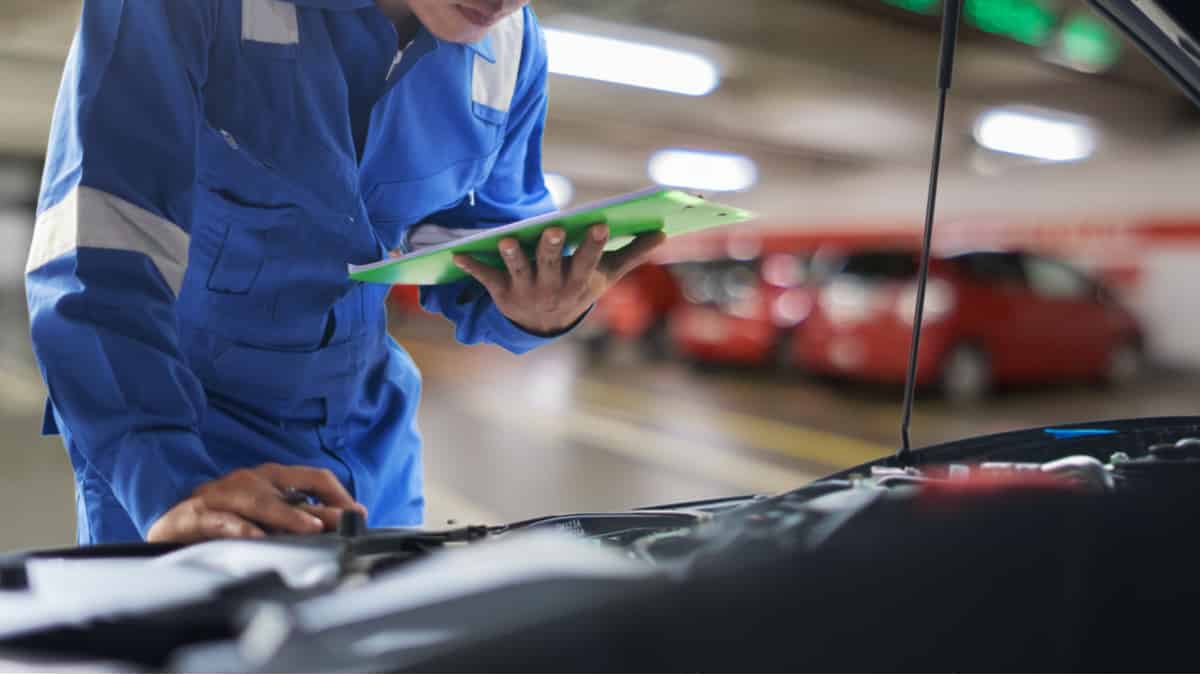
Most of the states in America require some sort of car inspection to register the vehicle. It’s your responsibility to ensure the inspection is complete and paid for, or you won’t be able to renew your registration. How much does a car inspection cost?
In this guide, I break down the average cost. I also examine used car inspections and show you what systems should be looked at before you purchase a vehicle.
You can spend anywhere from $7 to $70 to get your annual car inspection. The price depends on what state you live in and what’s required. If you want a used car inspection before buying a car, you should expect to pay $100 to $350, depending on what systems you want to be checked.
For the annual safety inspection, you can visit any shop that works with the state. However, when you want a used car inspection, you can ask any mechanic for help – even someone in your family or a friend.
Car Inspection Costs in Top States
1. california.
In California, drivers must get a vehicle inspection every two years. As part of this inspection, you must also pass an emissions test. If you fail the emissions test, you won’t be able to get your registration renewal, and you could be fined.
On average, the safety inspection should cost between $25 and $75. The price varies depending on where you get the inspection done and what type of vehicle you have.
Unless you have a brand-new car, you are required to get a Texas safety inspection every year. In some counties, you are also required to have emissions testing.
For a 1-year safety inspection on most passenger vehicles, you will spend $7. Emissions testing can add another $11.50 to $22.50. Prices will also be different if you are inspecting a commercial vehicle or moped.
The fees for inspection in Florida are set by the establishment providing the service. For this reason, you’ll want to shop around.
Some auto shops perform inspections for free if you are already a customer. Otherwise, you can find some shops that charge $99 or more for a safety inspection.
4. Pennsylvania
This is another state that allows inspection fees to be determined by the provider. For this reason, you might spend as little as $25 for the inspection and $30 for emissions testing.
If you want to save money, I recommend shopping around for the best rate. Even if you have to drive a few minutes for the savings, it might be worth it.
5. New York
In New York, vehicles are expected to be inspected yearly and most also require emissions testing. Most light-duty vehicles cost $10 for inspection and $11 or $27 for emissions.
The prices will be different if you have a diesel vehicle. There are also different charges for larger vehicles and motorcycles.
States That Don’t Require Car Inspection
Car inspection isn’t required in every state. These seven states do not have laws requiring car inspections.
- Alaska
- Arkansas
- South Carolina
- South Dakota
In Mississippi and Michigan, car inspections are only required in special circumstances. As an example, if you rebuild a car that has a salvage title in Michigan, you will have to get it inspected for registration. Additionally, Mississippi requires that cars containing tinted windows get inspected.
Alaska and South Carolina used to require safety inspections, but have since turned away from them. Alaska repealed its state inspection law back in 2012. Additionally, South Carolina hasn’t reintroduced inspections, but that doesn’t mean that will always be the case.
What Is Included in a Car Safety Inspection?
Every state has its own list of what’s needed to pass a safety inspection. In some states, emissions are required to get a passing grade.
Aside from that, most states require that the exterior lighting be examined. Additionally, the shop will want to know that the horn works, as well as the seat belts. Some stations will fail a car because there are warning lights on the dashboard , so you might need to get repairs before you pass the inspection.
Expect the shop to take your car for a ride. They will want to see that the steering and suspension systems are working properly to ensure safety. Plus, it’s the best way to try out the brakes. If you have tinted windows, the shop will also measure the percentage of light that can pass through to ensure it complies with state laws.
How Long Does a Car Safety Inspection Take?
If you are getting your annual or bi-annual safety inspection, you want to know how long you should plan to be at the shop. In general, the inspection should take thirty minutes or less, but that’s not what tends to take up the most time.
When you arrive at the shop, you have to wait in line behind other customers. If the shop doesn’t allow for appointments, you might be better off dropping the car and coming back later to pick it up.
Additionally, the car inspection could take longer if the mechanic finds something wrong with the vehicle. If it’s going to stop you from getting a new inspection sticker, you might want to have it fixed right away.
What’s Needed for Car Inspection?
Before you head to your local shop for a car inspection, you want to ensure that you have appropriate documentation. You will need your driver’s license, plus the car registration.
It’s also important to take your insurance cards with you. Most locations will not accept photocopies of this paperwork, so be sure to bring the originals. Additionally, you want to have the fee ready to pay. In some cases, you might be charged a fee to use a credit card, so you could consider paying with a check or cash.
What Should Be Inspected Before Buying a Used Car
1. steering/suspension system.
Before you purchase a used car, you want to be sure that the steering and suspension work as intended. Otherwise, you could have trouble controlling the vehicle on the road. The steering system is responsible for giving you control over which way the vehicle moves, while the suspension is needed to support the vehicle for a stable and smooth ride.
As part of a steering inspection, the mechanic looks at the bushings, U-joint , tie rod ends, idler arm and ball joints. They will also inspect the shocks, springs and struts to ensure everything is in optimal working order.
The car’s exhaust system is made up of many chambers and tubes designed to expel the exhaust gases created by the motor. The exhaust system is responsible for converting toxic gas from the engine into substances that are less harmful to the environment. It also helps to reduce the noise of the engine .
In a typical exhaust inspection, the catalytic converter, exhaust pipe, muffler and tailpipe will be examined. The mechanic should also inspect the oxygen sensors and exhaust manifold.
The brake system is designed to slow down the tires and stop the vehicle to avoid collisions on the road. This safety system must be working properly to ensure your maximum protection.
With a proper brake system inspection, the technician will measure the brake pad or shoe thickness. They will also measure the brake rotor thickness or brake drum diameter. However, there’s much more to the brake system than those main parts. A comprehensive inspection also looks at the brake hoses, parking brake, hardware, wheel cylinders, ABS, and calipers. Additionally, the brake fluid level should be checked and topped off if needed.
The car tires are the only part of the vehicle making contact with the ground, making them that much more important. If the tires or wheels are in bad shape, your on-road safety is compromised. With a tire and wheel inspection, a mechanic does a thorough investigation and looks for any faults.
For starters, the tires are checked for punctures or foreign objects. The tire pressure is also looked at and adjusted as needed. The technicians examine the tread to determine if it is wearing evenly. If a tire rotation is needed, it will be done.
During an inspection, wheel alignment is looked at, because when the alignment is off, the tires will wear prematurely. If the TPMS Light is on and the pressures are good, a sensor might also need to be replaced.
5. Major Systems
Aside from those systems, there are other major components that should always be checked. A mechanic will get under the hood to examine the belt tensioner and valve cover gasket. Spark plugs, the timing belt and the battery should also be checked.
All of the fluids should be checked. You want the windshield washer fluid, transmission fluid, oil, coolant and power steering fluid topped off when it gets low.
Categories: Estimator , Maintenance
Related Posts
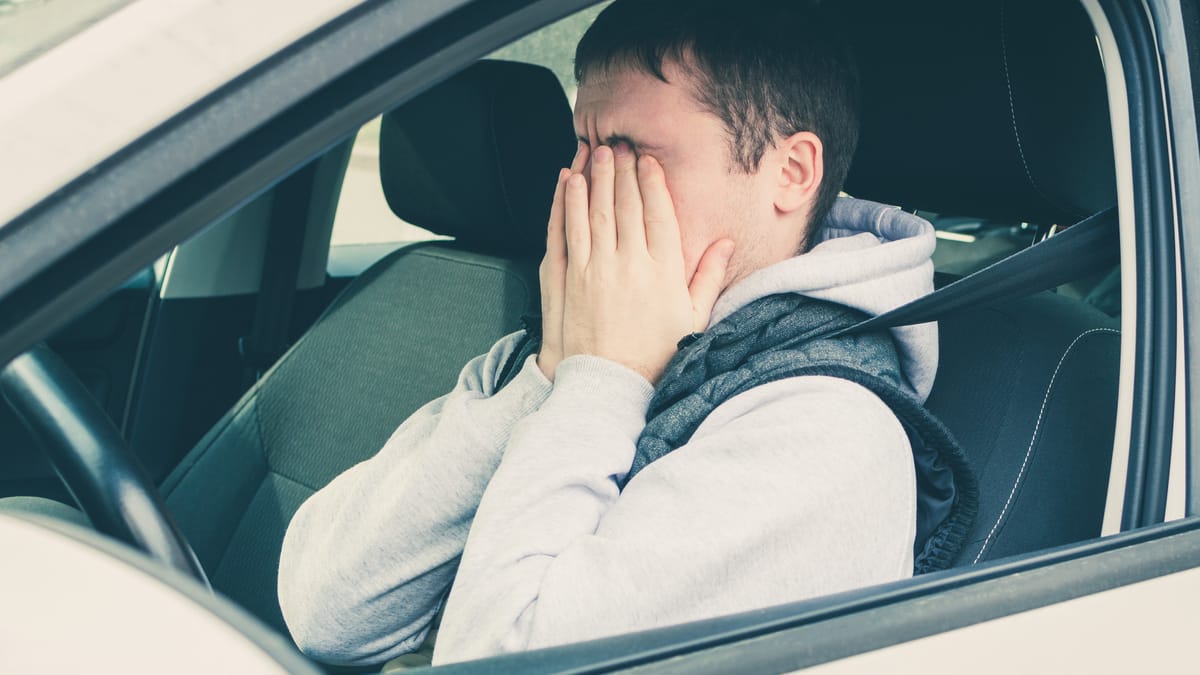
Latest Posts
- The Best & Worst Years Of Ford Explorer
- Best & Worst Years Of Toyota Corolla
- Best & Worst Years of Toyota RAV4
- When Should Your Child Switch To A Forward-Facing Car Seat?
- The Best & Worst Years Of Toyota Camry
- I Accidentally Put Premium Gas In My Car, What To Do?
- Fleet Training
- CDL Training
- Insurance Discount
- Court Diversion
- Our Courses
- What is the SPIDER Method?
Pre-Trip Inspection: An Essential Guide for Commercial Drivers
Why are pre trip inspections essential, and how can they make a difference in the daily lives of truck drivers? With safety, regulatory compliance, and preventative maintenance on the line, pre trip inspections are a crucial aspect of ensuring smooth and efficient operations on the road. In this blog post, we dive into the critical components of pre trip inspection and provide valuable tips and resources to help drivers stay ahead of potential hazards and costly repairs.
- Pre-trip inspections are essential for promoting safety, compliance, and cost savings while on the road.
- The pre-trip inspection process should take approximately 10–15 minutes and include items such as braking systems, steering & suspension systems, emergency equipment & engine compartment.
- Establishing a routine for pre-trip inspections with sufficient time to check all components is key to ensuring vehicle safety and regulatory compliance. Accurate records must also be kept.
The Importance of Pre-Trip Inspections
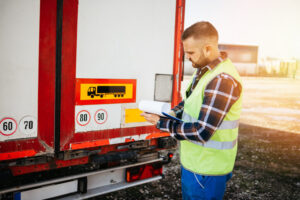
- Lessen accident risks
- Comply with regulations
- Maintain the vehicle’s condition
- Avert expensive repairs and downtime
Frequent inspections, such as periodic inspection, are important for maintaining safety and preventing costly issues.
The benefits of conducting pre-trip inspections include:
- Ensuring safety and compliance with regulations like DOT inspections
- Preventing fines, penalties, and potential harm to the driver’s or company’s reputation
- Acting as preventative maintenance, catching minor issues before they escalate
- Saving time, reducing repair costs, and minimizing downtime
Safety Concerns
Ensuring the vehicle’s safety is of paramount importance when conducting pre-trip inspections. A thorough examination of various components is necessary, including:
- Fire extinguishers
- Brake lights
This enables drivers to spot potential hazards and affirm the vehicle’s operational readiness, ultimately reducing the risk of accidents, in line with the goals of the Commercial Vehicle Safety Alliance.
However, the consequences of neglecting a thorough pre-trip inspection can be severe. Overlooking potential hazards may render the vehicle unfit for operation, increasing the risk of collisions. An inspection focused solely on the vehicle can spot these hazards and confirm the vehicle’s safety, underlining the significance of a thorough pre-trip inspection.
Regulatory Compliance
The Federal Motor Carrier Safety Administration mandates pre-trip inspections as part of DOT inspections for commercial motor vehicles, requiring drivers to acknowledge and certify that appropriate repairs have been made before commencing a trip. Non-compliance with pre-trip inspection regulations can result in fines, penalties, and harm to a driver’s or company’s reputation. Conducting periodic inspections can help maintain compliance and ensure the vehicle’s safety.
A Driver Vehicle Inspection Report (DVIR) is an essential tool to guarantee regulatory adherence. Watching a pre-trip inspection video can help drivers understand the process and ensure they follow the correct procedures, further emphasizing the need for thorough pre-trip inspections.
Preventative Maintenance
Preventative maintenance is an essential aspect of vehicle upkeep, aiming to prolong the lifespan of corporate assets, equipment, and infrastructure. By inspecting, cleaning, lubricating, adjusting, and replacing parts as necessary, drivers can detect minor issues before they escalate into major problems, saving time and money on repairs and reducing downtime.
The advantages of preventative maintenance include enhanced safety, increased efficiency, and minimized downtime. By incorporating pre-trip inspections into a regular maintenance routine, drivers can ensure their vehicles remain in optimal condition and avoid unexpected breakdowns or costly repairs.
Pre-Trip Inspection Process
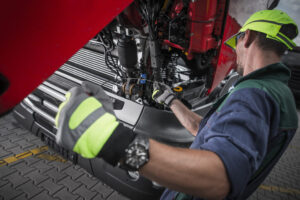
Conducting pre-trip inspections at the start of each shift and each time a trailer swap occurs is integral. Such regularity aids in upholding the vehicle’s safety, roadworthiness, and regulatory compliance while also acting as preventative maintenance. The average inspection should last between 10-15 minutes, allowing enough time for a thorough examination of all components.
Engine Compartment
Inspecting the engine compartment is a critical part of the pre-trip inspection process. Drivers should examine the engine for leaks, fluid levels, belts, hoses, and other critical components to ensure optimal performance and prevent breakdowns. This includes checking the water pump, power steering pump, and alternator for any signs of leakage, fraying of belts, and ensuring that all components are securely mounted.
Additionally, drivers should verify the location of the dipstick and the appropriate oil level, as well as inspect the coolant system for proper levels, hose conditions, and secure mounting at both ends. By carefully examining each part of the engine compartment, drivers can maintain their vehicle’s performance and avoid unexpected issues on the road.
Exterior and Tires
A thorough inspection of the vehicle’s exterior and tires is crucial for ensuring its safety and roadworthiness. This includes checking the lights, reflectors, fuel tank, battery, and tires for any damage or wear that could impact safety or performance. Tires should be inspected for adequate tread, cuts, bubbles, or gouges, and to make sure there are no foreign objects, such as stones or large debris, between the wheels and no space between tires and rims.
Moreover, it is vital to check and maintain the appropriate air pressure in the tires to ensure optimal performance and prevent tire-related accidents. By carefully inspecting the exterior and tires, drivers can guarantee a safer and more efficient driving experience.
cabin and Controls
The cabin and controls of a commercial vehicle play a crucial role in the driver’s safety and comfort on the road. During a pre-trip inspection, drivers should examine the cabin for proper functioning of:
- other essential equipment
They should also ensure the availability of emergency equipment.
In addition to checking seatbelts, mirrors, seat position, steering wheel, pedals, windshield, lights, turn signals, ABS lights, gauges, windshield wipers, and horns, it’s essential to verify that all required emergency equipment, such as fire extinguishers, warning devices, and first aid kits, are present and in good working condition.
By thoroughly inspecting the cabin and controls, drivers can ensure a safe and comfortable driving experience.
Essential Items on a Pre-Trip Inspection Checklist
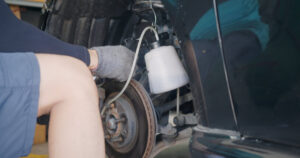
In addition to the aforementioned items, a pre-trip inspection checklist should also include the engine compartment, exterior and tires, and cabin and controls, as previously discussed. Combining all these components in a well-structured checklist ensures a thorough and effective pre-trip inspection that promotes safety and compliance.
Braking System
The braking system is a vital component of any vehicle, and a thorough inspection is necessary to ensure proper functionality and safety. During a pre-trip inspection, drivers should examine all components of the braking system, including air brakes, parking brakes, and hydraulic systems.
Specifically, drivers should inspect the following parts of the service brake system for any signs of wear or damage:
- Brake chamber
- Slack adjuster
By carefully examining each part, drivers can guarantee the vehicle’s safe operation and prevent potential accidents due to brake failure.
Steering and Suspension
A vehicle’s steering and suspension systems play a significant role in ensuring proper handling and a smooth ride. During a pre-trip inspection, drivers should inspect the steering components, suspension system, and wheel alignment to guarantee the vehicle’s optimal performance.
Specifically, drivers should examine the following components of the steering and suspension systems:
- Ball joints
- Tie rod ends
- Strut mounts or shock towers
- Steering effort for both manual and power systems
By thoroughly inspecting these components, drivers can maintain the vehicle’s handling capabilities and provide a comfortable driving experience.
Emergency Equipment
Ensuring the presence and proper functioning of emergency equipment is a crucial part of a pre-trip inspection. Drivers should verify that all required emergency equipment, such as fire extinguishers, warning devices, and first aid kits, are present and in good working condition.
In addition to these items, drivers should also be familiar with the location and operation of any other emergency equipment required by law or their specific company. By confirming the availability and functionality of emergency equipment, drivers can be prepared for unforeseen situations and enhance the overall safety of their vehicle.

Digital Tools and Resources for Pre-Trip Inspections

- Mobile apps that provide checklists and guides for conducting pre-trip inspections
- Online videos and tutorials that demonstrate best practices for inspecting different parts of the truck
- Websites and forums where drivers can stay updated with the latest regulations and requirements for pre-trip inspections
By leveraging these digital tools, truck drivers can enhance their knowledge and efficiency when it comes to pre-trip inspections.
These digital resources not only simplify the pre-trip inspection process but also help drivers maintain compliance with regulations and support preventative maintenance efforts. By leveraging technology, drivers can enhance their pre-trip inspections and promote safety and efficiency on the road.
Mobile Apps
Mobile apps designed for pre-trip inspections can greatly benefit truck drivers by creating checklists, tracking progress, and storing records digitally for easy access and compliance. Some popular mobile apps for pre-trip inspections include iAuditor, Whip Around DVIR software, Teletrac Navman Pre-trip Checklist tool, and Titan GPS Digital Pre-trip Inspection.
By utilizing these apps, drivers can:
- Generate checklists tailored to their specific vehicle and requirements
- Monitor their progress throughout the inspection
- Maintain digital records for future reference and compliance purposes
This not only simplifies the driver only inspection process but also ensures that drivers are following a thorough and effective routine.
Online Videos and Tutorials
Online videos and tutorials serve as valuable resources for truck drivers looking to enhance their pre-trip inspection skills and knowledge. By accessing these resources, drivers can learn best practices for conducting pre-trip inspections and stay updated on regulations and requirements.
Drivers can find online resources on websites, YouTube channels, and other digital platforms that provide informative and instructional content on pre-trip inspections. By staying informed and utilizing these resources, drivers can ensure they are conducting thorough and effective pre-trip inspections that promote safety and compliance.
Tips for a Successful Pre-Trip Inspection
To ensure a thorough and effective pre-trip inspection, truck drivers should establish a routine, take their time, and keep accurate records. Following these tips allows drivers to boost safety, comply with regulations, and bolster preventative maintenance efforts.
Adopting a consistent routine for pre-trip inspections helps ensure that all components are checked and nothing is overlooked. Here are some tips to follow:
- Allow sufficient time for a thorough inspection, typically between 15-30 minutes, to prevent missed issues and potential safety hazards.
- Check all essential components, including tires, brakes, lights, mirrors, and fluid levels.
- Keep detailed records of the inspections, including any issues identified and actions taken.
Regularly review and update your inspection checklist to ensure it covers all necessary items. By following these tips and maintaining a consistent pre-trip inspection routine, you can demonstrate compliance and support preventative maintenance efforts.
Establish a Routine
Developing a consistent routine for conducting pre-trip inspections is crucial for ensuring all components are checked and nothing is overlooked. Adhering to a systematic process lets drivers ensure the vehicle’s safety, roadworthiness, and regulatory compliance.
Some recommended components to include in a pre-trip inspection routine are:
- The engine compartment
- Exterior and tires
- Cabin and controls
- Braking system
- Steering and suspension
- Emergency equipment
By incorporating all of these components into a well-structured routine, drivers can guarantee a thorough and effective pre-trip inspection.
Take Your Time
Allowing sufficient time for a thorough pre-trip inspection is essential to prevent missed issues and potential safety hazards. An average inspection should last between 15-30 minutes, giving drivers enough time to examine all components in detail and ensure the vehicle’s safety and roadworthiness.
Allocating time for pre-trip inspections helps drivers reduce the risk of missing critical issues and affirm the vehicle’s operational readiness. Remember, a thorough vehicle only inspection is not only essential for safety but also for compliance with regulations and preventing costly repairs down the line.
Keep Accurate Records
Maintaining detailed records of pre-trip inspections is essential for demonstrating compliance with regulations and supporting preventative maintenance efforts. Drivers should document any issues identified during the inspection, along with the actions taken to address them.
Maintaining accurate records enables drivers to easily refer back to past inspections and monitor the vehicle’s maintenance history. This not only helps ensure compliance with regulations but also supports proactive maintenance initiatives that can prevent major issues and costly repairs.
In Conclusion
Pre-trip inspections are an essential aspect of ensuring safety, compliance, and preventative maintenance for truck drivers. By following a systematic process, utilizing digital tools and resources, and implementing practical tips, drivers can guarantee thorough and effective inspections that promote safety and efficiency on the road. Remember, a well-executed pre-trip inspection not only minimizes risks but also contributes to a smoother and more enjoyable driving experience.
Frequently Asked Questions
Which of these items should be checked in a pre-trip inspection.
A pre-trip inspection should include thorough safety inspections of the coupling system, vehicle lights, engine compartment, tires and brakes, chassis, fuel tanks, and an in-cab inspection, and must be logged in your logbook as “on duty not driving.” This inspection should be done before every trip to ensure the safety of the driver and other motorists. It is important to check the coupling system for any signs of wear or damage, as well as the vehicle lights, engine compartment, tires and brakes, chassis, and fuel tanks. Additionally, an in-cab inspection should be conducted to ensure that all safety requirements are met.
What is the first step in the pre-trip inspection?
The first step of the pre-trip inspection is to check under the hood, starting at the front of the vehicle and inspecting the various components of the truck’s engine compartment. Begin by checking the oil level, coolant level, and power steering fluid level. Make sure all hoses and belts are in good condition and that all fluid levels are at the proper levels. Check the battery terminals and cables for corrosion and make sure the battery is connected and functioning.
What are the ABSC in a pre-trip inspection?
Pre-trip inspections involve inspecting all parts of a truck and trailer for abrasion, bruises, cuts, bent, broken or cracked parts, and ensuring all air and liquid-holding parts are not leaking. It’s recommended to do the inspection in order, starting with the truck and then the trailer, touching each part and working from the top down and from the center out while wearing gloves.
Which is not checked during an exterior pre-trip inspection?
The reservoir sight glass of the coolant level is not checked during an exterior pre-trip inspection, whereas the oil pressure gauge, wiper arms and blades, horn and heater/defroster should all be checked.
What does DOT mean in inspection?
DOT stands for U.S. Department of Transportation and a DOT inspection is conducted to ensure that commercial motor vehicles are up to standards and safe for public use.

Everything You Need to Know About CDL Medical Requirements

CDL Hours of Service Regulations – Everything You Need to Know
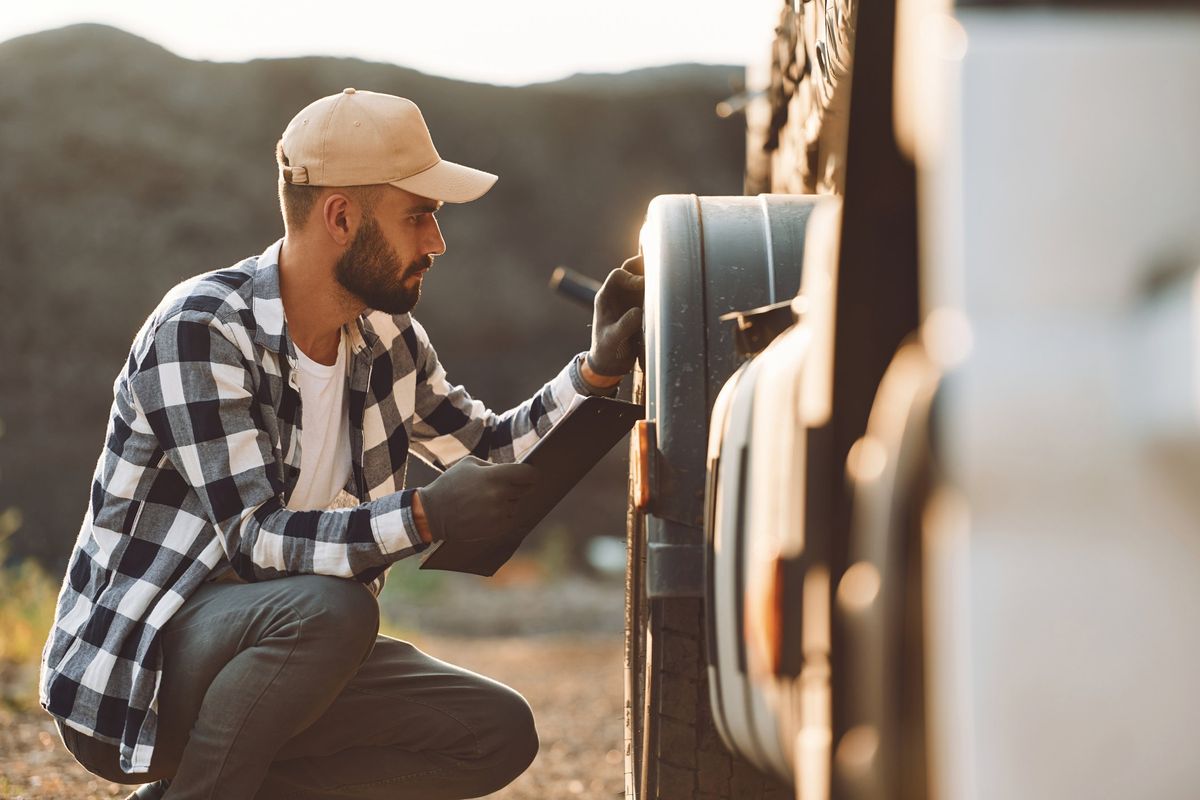
Pre-Trip Inspections: Know Before You Go
You leave your truck for the night and return the next morning. In between, anything could happen. How do you know your vehicle is still in tip-top shape? You won’t unless you conduct a thorough pre-trip inspection.
The Federal Motor Carrier Safety Administration (FMCSA) requires pre-trip inspections every time you start a shift. If you’re running late or in a hurry, it’s tempting to skip the inspection or cut corners. But if you’re not careful, you could suffer a breakdown or blowout, damage your truck and harm yourself and others on the road.
Set aside between 15 and 30 minutes for a proper inspection, and don’t rush through it. Try to follow the same sequence every time so you don’t miss any steps. Avoid common vehicle out-of-service violations and protect your truck with these extra tips:
Light all lamps. Look for burnt-out headlight bulbs, both on low-beam and high-beam. Check all other lights, including brake lights. Make sure your turn signals work properly. Fasten any loose light covers. Verify all reflectors are on the truck and trailer in the proper places.
Evaluate your braking system. Adjust brakes properly. Ensure brake hoses and lines are securely mounted and free from any cuts, frays or damage.
Inspect every tire. Tires wear differently depending on their position, so scrutinize all of them. Look for any cuts, damages or bulges. Maintain a tread depth of at least 4/32-inch. Measure tire pressure with a gauge (not a tire thumper) and maintain 90 – 100 psi. Tighten any loose lug nuts and report any missing ones. Listen for any air leaks.
Look underneath and inside your trailer. Check for signs of debris and even people—we’ve heard reports of drivers finding people sleeping under their truck or inside their truck. Remove any tree limbs or other objects from your path. Confirm your landing gear is fully raised.
Examine the fifth wheel. Make sure no gaps exist between the fifth wheel and the trailer apron. Inspect the kingpin and locking jaws.
Peek under the hood. Check your oil, coolant, transmission, wiper and power steering fluids and fill if needed. Inspect power steering hoses for any cracks or damage.
Don’t forget your emergency kit. Pack flares, triangles and other safety devices. Make sure your fire extinguisher is charged and secured—this is a common vehicle out-of-service violation.
Get comfortable in the cab. Adjust your driver’s seat and all mirrors before you start your truck.
Document any defects. Fill out a Driver Vehicle Inspection Report (DVIR) whenever you spot any broken or missing parts so your motor carrier can repair your vehicle quickly.
- 4 Things Drivers Should Know About Wheel Ends ›
- Brake Safety: 10+ Tips to Pass an Inspection ›
- Pre- and Post-Trip Inspection Dos and Don'ts ›

- Buy A Franchise
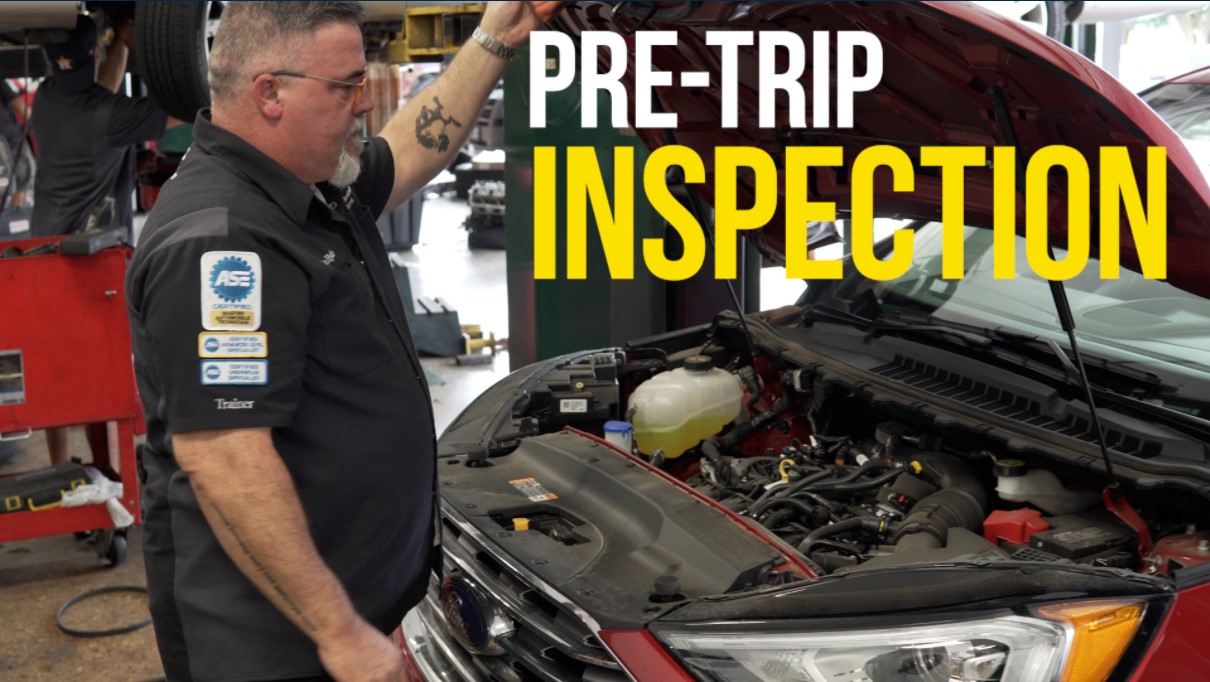
Pre-Trip Vehicle Inspection
The open road is calling! But, before you jet out for a road trip, it’s important to ensure your vehicle is in good working condition to handle the long journey ahead. In this #cartalk video blog, Joe Hyde, Director of Automotive Technology, walks us through the important car systems and components to double-check before a long road trip.
“Hi there, I don’t know about you, but I’m excited to get on the road again. And if you’re considering a trip anytime soon, you may want to consider having a pre-trip inspection performed on your vehicle. I’m Joe Hyde, Director of automotive technology for Christian Brothers automotive. Let’s talk cars.”
“So let’s go take a look under the hood, and look at some of these pre-trip inspection items that you may need to check.”
A Visual Inspection
“So first up on your pre-trip inspection, you want to give the vehicle a good visual inspection, you just want to kind of walk around the vehicle and see if you notice anything that is considered abnormal, maybe a low tire, cracked windshield, things of that nature things that you want to look for.”
Check Your Fluids: Motor Oil, Cooling System, Transmission Fluid & Brake Fluid
“Next up after that, we want to check the fluids under the hood. First up will be our oil. Usually, you’ll find that most vehicles have an indicator, it’ll be indicated by a yellow handle. And you simply want to grasp it firmly, use a paper towel or shop rag and check it and make sure it’s within operating range.”
“Next on the fluid list for pre-trip inspection is going to be the cooling system. And usually on today’s modern cooling systems, you’ll find what they call a degas or a reservoir bottle. Now this is just a visual inspection and we just want to make sure that it’s within the minimum to the maximum operating range, as you can see here.”
“Many of today’s modern vehicles do not have a way to check your transmission fluid, as is in the case of the vehicle that we have here today. Please check your owner’s manual to make sure that you don’t need to check your transmission fluid before any trips.”
“Another fluid on our inspection list, is a visual inspection of where the brake fluid level is. And it can be found under the hood as well. Here we’re just checking to make sure that the fluid is in the operational range between min and max. And in this case, the vehicles at the normal level.”
“In the event that you find any of the fluids are not within operating range, it’s a great time to schedule an appointment with your local Christian Brothers Automotive, so you too can have that service appropriately.”
Wiper Blades & Washer Fluid
“Now we’re going to check the condition of our wiper blades and making sure that we have enough washer fluid for the vehicle. Usually your washer fluid can be found and indicated with a blue cap underneath the engine compartment. Simply lift the lid and fill to the desired fill level. Now we’re going to check the condition of the wiper blades, and we just want to lift up gently, and we just want to make sure that there’s no nicks, cuts, splits, and that it feels kind of soft to the touch. And my recommendation when it comes to wiper blades, is when there’s a change of season, it’s usually a good time to change those wiper blades out.”
Visually Inspect Your battery
"Next on our inspection list, we’re going to visually inspect our battery. Here, we’re just making sure that it looks normal and you don’t have a science project growing out of it. So in this vehicle, this is where the battery is located. So I’m gently going to pull the cover back off of the battery post and I’m just going to look at it. It looks nice and clean. I’m going to feel it with my hand, it feels nice and tight. I’m going to place the cover back over it. And then if you can reach it and it’s safe to do so you can check the ground cable as well and it feels good."
Tires & Tire Pressure
"One of the most important things on our pre-trip inspection is our tires and the tire pressure. Most vehicles today have a sticker that tells you how much air pressure should be in your vehicle. If you look on the inside of the doorframe on most of today’s vehicles, you’ll find the tire inflation certification label. This is the recommendation of the proper air pressure for this particular vehicle according to the manufacturer."
"When checking your tires, make sure that you always check your spare. You can consult your owner’s manual for more information about where your spare is located, and what the proper inflation should be. Before those long travel trips, you want to make sure that your spare is properly inflated, that you have a lug wrench to be able to change the tire and a jack to be able to lift the vehicle."
"Many of the items on our pre-trip inspection are certainly things you can handle yourself at home, but in the event that you find any concerns or need further inspection of your vehicle, the certified technicians at Christian Brothers Automotive are certainly available for assistance. I’m Joe Hyde, and this has been another edition of Let’s Talk Cars."
Related Articles
[1].jpg)
- Oil & Filter Change
- Tire Rotation
Sunwash-Tech-with-Customer.jpg)
- Courtesy Inspections

- Fuel System
- General Tips
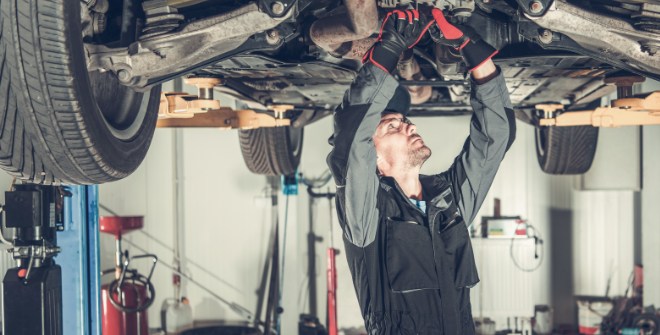
Schedule an Appointment with Your Local Christian Brothers Automotive Location Today
Find Your Closest Christian Brothers Automotive Location Today
"Outstanding Service!"
Tracy Crosby
"Fantastic Customer Service!!!"
Patti Beckwith
"Honesty in Spades"
Tim Kuelker
Complete pre-trip inspection checklist for truck drivers
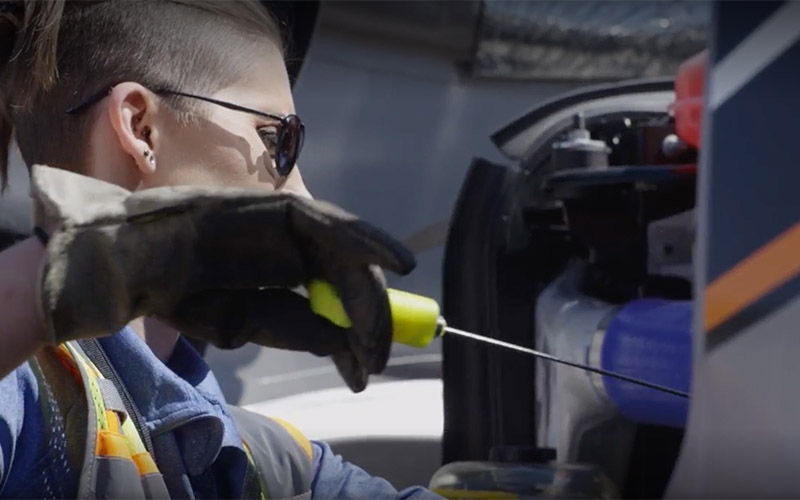
By The Schneider Guy
Estimated reading time: 4 minutes
As a truck driver, performing a CDL pre-trip inspection is one of the most common and repeated tasks you will complete. Pre-trip inspections help truck drivers ensure their tractor and trailer are safe to operat e before hitting the road.
Keep reading to learn what a p re -trip inspection is and what should be on a p re -trip inspection checklist .
What is a pre-trip inspection?
A pre-trip inspection includes checking over the tractor and trailer a truck driver will be operating . A pre-trip should be completed before the operation of a vehicle :
- At the beginning of a driver’s shift.
- Any time a new trailer is picked up.
- After a 10-hour break.
A thorough inspection usually takes anywhere from 30 minutes to one hour and should be logged as on-duty, not driving (line 4) .
How to complete a CDL pre-trip inspection
CDL pre-trip inspection checklist
1. passenger-side engine: .
- Air filter housing: Secure mounting, cover in place.
- Windshield washer fluid reservoir: No leaks, proper fluid level.
- Turbocharger: No oil or exhaust leaks.
- Engine air ductwork: No cuts, clamps secured.
- Alternator: Mounting secured, no broken or loose wire.
- Accessory drive belt: Not cracked or frayed.
- Air conditioner compressor: Secure m ounting .
2. Front brakes (covers all five brake components):
- Brake drum: No cracks.
- Brake lining: No cracks or damage.
- Slack adjuster: Proper angle to the brake chamber, clevis and cotter pin intact.
- Brake air line: No bulges or cuts, fitting tight .
- Brake chamber: Mounting bolts secured, band clamp secured.
3. Front wheel:
- Tire: ABCs (abrasions, bulges, cuts), pressure = 120 PSI, tread depth = 4/32 min ( DOT ) .
- Wheel: Not cracked or bent.
- Hub oil: Not leaking, at proper level – if it’s a sealed unit, can’t check level.
- Oil seal (outer): Not leaking.
- Valve cap: Not missing.
- Lug nuts: None missing, no streaks or shiny areas, none loose.
4. Driver side of engine:
- Radiator brace: No cracks or missing bolts.
- Radiator: Not leaking, secure mounting.
- Water pump: No cracks, not loose or leaking.
- Fuel water separator/filter: Not leaking, secure mounting.
- Pitman arm/drag link: Not cracked, castle nut secured with cotter pin.
- Steering gear box: Secure to frame, not leaking.
- Power steering reservoir: Secure mounting , no leaks, proper level.
- Dipstick: Right level, secured after check.
- Steering shaft: Secure, not loose or damaged.
- Fuel pump: No cracks, not loose or damaged.
- Oil filler cap: Secure, no cracks.
- Engine coolant reservoir: No leaks, proper fluid level.
5. Steer axle suspension:
- U-bolts: No cracks, no loose or missing nuts.
- Leak spring: No cracks, not loose or shifting.
- Tie rod: Secured with castle nuts and cotter pins.
- Shock absorber: Secure mounting, not leaking oil.
- Axle: Not cracked.
6. Rear suspension:
- Spring mount: No cracks, secure mounting.
- Tire: ABCs (abrasions, bulges, cuts), pressure = 110 PSI, tread depth = 2/32 min ( DOT ) .
- Airbag (bellows): Fully inflated, secure mounting, not ruptured.
7. Side of cab:
- Mirrors: Secure m ounting , no broken glass.
- Doors: No damage, glass not broken, hinges secured, opens and closes well.
- Lights and turn signals: Working, not cracked.
- Steps: Mounted, secured to skirting.
- Battery box: Secure m ounting , cover latched.
- DEF cap: Cap secured.
- Fuel cap/tank: Gasket in place, vent in place, chain secures the cap to the tank.
- Side skirting: No damage, panels secure.
- Side box: Secured, safety triangles present.
- Side of sleeper berth: No body damage.
- Sleeper berth window: No cracks.
8. Rear of cab:
- Electrical cord: No bare wire, no corrosion, check the plug at the end of the cord.
- Air line: Not tangled or worn, rubber grommets not worn, fittings tight.
- Cab shock absorber: Secure mounting, not leaking oil.
- Cab airbag (bellows): Not ruptured, securely mounted.
9. Driveshaft/rear frame:
- Driveshaft: Not cracked.
- Universal joint: Not cracked, not missing bolts, no shiny areas.
- Differential: Not leaking oil.
- Frame: Straight, no non-factory welds.
10. Fifth wheel area:
- Pivot pin: Keeper pin and cotter key intact.
- Slider lock pins: Fully engaged.
- Release arm: Not bent.
- Slider rail: No broken welds or missing bolts.
- Slider stop blocks: Welds not broken, not missing bolts.
- 5th wheel platform: Well-greased, tilted down.
11. Front of trailer:
- Top rail: No cracks or collision damage.
- Clearance lights: Not broken, working properly.
- Registration: Not missing, readable.
- Document box: Not missing or loose.
- Air line /glad hands: No bulges or cuts in air lines, rubber grommets not damaged on glad hands.
- Electric hook up: No broken pins, cover intact.
- PM sticker: Current, legible.
- Height sticker: Legible, legal for route.
- Placard holder: Not broken or missing rivets.
- Tracking device: No cracks or collision damage.
12. Side of trailer:
- Top rail: Not cracked, no collision damage.
- Clearance light: Not broken, operational.
- Bottom light: Not cracked, no collision damage, no missing bolts.
- Landing gear: Legs straight, no broken welds in bracing, sand pads secured and clean handle in cradle.
- Reflector tape: Clean.
- Side panels: No holes or cuts, no missing rivets.
13. Rear of trailer:
- Latches: Secured, not damaged.
- Lights: Not broken or missing, operational.
- Splash guard: Brackets and guard secured.
- License plate: Secure and clean, light is working.
- Bumper: Not damaged, no broken welds.
- Door hooks: Not loose, no missing bolts.
- Hinges: Not cracked, no missing bolts on both sides.
- Door seals: No separation, no rubber tubing sticking out.
14. Trailer suspension:
- Air line: No bulges or cuts, fittings are tight and not rubbing.
- Axle: Not bent or broken.
- Clevis pin/cotter key: Not missing.
- Slack adjuster: Proper angle, clevis pin and cotter pin intact.
- Brake linings: Minimum of ¼ inch thick, not cracked.
- Brake drum: Not cracked.
- Tire: (ABCs), tread depth = 2/32 , air pressure = 110 PSI.
- Spring: Not broken, not shifted.
- Spring mount: No broken welds.
- U bolts: Not loose, not cracked.
- Torque rod: Secure mounting, bushings intact.
- Spring brake chamber: Secure m ounting , band clamp secure.
15. Gauges/inside the truck:
- Fuel: Matches visual when looking in the tank.
- Def level: Maintain a minimum of one light bar.
- Oil pressure: 25-50 PSI.
- Speedometer: 0-60 MPH.
- Air pressure: 90-120 PSI.
Please note that the list above is just an example. It is important to remember the type of driver you are, the company you work for and the type of truck you drive can impact your CDL pre-trip inspection . Be sure to consult your company guidelines or speak with your leader for more information on your post-trip inspection requirements.
Get more great driving tips and guides.

Schneider Guy loves the "Big Orange." He's passionate about the trucking industry and connecting people to rewarding careers within it. He's been the eyes and ears of our company since our founding in 1935, and he's excited to interact with prospective and current Schneider associates through "A Slice of Orange."
Related posts

8 CDL Road Test tips to help you pass
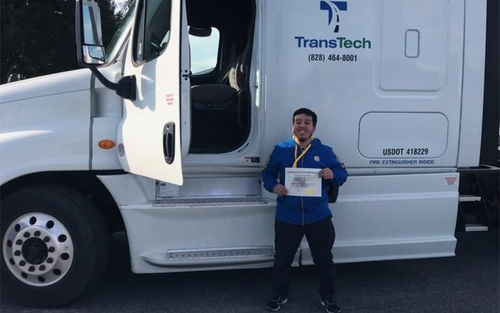
How hard is it to get a CDL?

How to get your CDL – 7 simple steps for new truck drivers

Caliber Auto Care: Free Road Trip Car Check
Before your next road trip, come to Caliber Auto Care for a complimentary car check. Our experts will check oil levels, tire pressure, tire integrity and more to ensure your car is working properly so you can focus on the journey ahead.
Let us do a complimentary car check for you
Our technicians will check your vehicle for free, and if we find an issue, we will always consult you before we make any adjustments or repairs.
- Come in a week before your trip, just in case any repairs are needed
- We’ll run a test on all safety components and major parts of your vehicle>
- We will lay out the severity of any issues, and what problems they may cause if not repaired
- We’ll never sell you services you don’t need
- You’ll leave with peace of mind that your vehicle is ready for the road ahead
How can we help get your car trip-ready?
We know not everyone is a car expert, that's why Caliber Auto Care offers free car checks to get your car trip-ready. According to Allstate , there are six key things you should have checked before your next trip.
- Check your vehicle’s battery to ensure connections are tight and corrosion free
- Check all belts and hoses for wear
- Check that your headlights, signals and windshield wipers are all working properly
- Top off all fluids including engine oil, windshield wiper fluid, power steering and transmission fluids and replace filters
- Check the vehicle's brakes and pads
- Check your tire tread and fill all tires to your car’s PSI requirements - including your spare tire
If we find any issues, Caliber Auto Care can perform any maintenance and repairs needed to keep your road trip on schedule.
Why Caliber Auto Care?
We do things The Caliber Way. This means Caliber Auto Care is committed to building trust through transparency. Our team will always educate you on your car’s health and offer straightforward solutions and pricing, so you can make the right decision for you and your family. We know how important your car is to you, so we make it easy to schedule and complete all your repair and maintenance services in one place.
Learn More About Our Trip Check
Regular car maintenance tips, fall car care checklist, a guide to summer road trip preparedness, summer road trip preparedness: a car care checklist, importance of getting a complete car diagnostic test, car maintenance myths debunked, find a caliber auto care near you, caliber auto care takes the place of your dealership’s service department and your local quick oil and mechanical repair shop with efficient, high-quality auto repair or maintenance services at an affordable price., we know that scheduling car care services between work, school and play can be a hassle. that’s why we make it as easy and straightforward as possible, offering you neighborhood convenience, superior service, comfortable waiting areas or free local shuttle service and the option of staying in your vehicle for some services while we work. it’s all about meeting your needs and standing behind our work., how can we help let’s get you back on the road.
Schedule an appointment
Find a time that works best for you and we’ll start Restoring the Rhythm of your Life.
Get an estimate
Tell us about you and your vehicle to get a free initial repair estimate.
If there’s something specific you need help with, let us know.
Platform Overview
The Connected Operations Cloud
Apps & Driver Workflows
Messaging, dispatch, documents, ELD
Video-Based Safety
AI cameras, driver coaching, safety reports, in-cab alerts
Equipment Monitoring
Location tracking, utilization, continuous diagnostics
Vehicle Telematics
Real-time GPS, routing, fuel, maintenance, electrification
Site Visibility
Remote visibility, proactive alerting, on-the-go access
Integrations
Developer API
Start building with our API
App Marketplace
Install turnkey integrations
OEM Integrations
Unlock embedded telematics data
Experts Marketplace
Find certified Samsara experts
By Business Need
Reduce costs across your business
Automate regulatory compliance
Ensure safety wherever you operate
Identify and eliminate risks
Sustainability
Prepare for transition to renewables
Customer Experience
Build customer loyalty and retention
By Industry
Transportation & Logistics
Food & Beverage
Field Services
Construction
K-12 Schools
Higher Education
Passenger Transit
Customer Success
Customer Stories
Education & Training
Customer Support
Help Center
Developer Portal
Customer Tips
Case Study Highlight

DHL consolidates 7 separate point solutions with Samsara’s integrated platform
Read more ➔

Nutrien Ag Solutions
Nutrien Ag Solutions cuts distracted driving in half 90 days after installing AI Dash Cams
Video Library
Product Tours
Fleet Safety Guide
Business Resilience

State of Connected Operations
See how leaders are adopting cutting-edge technologies, empowering their workforce, and unlocking new revenue streams.
Optimization
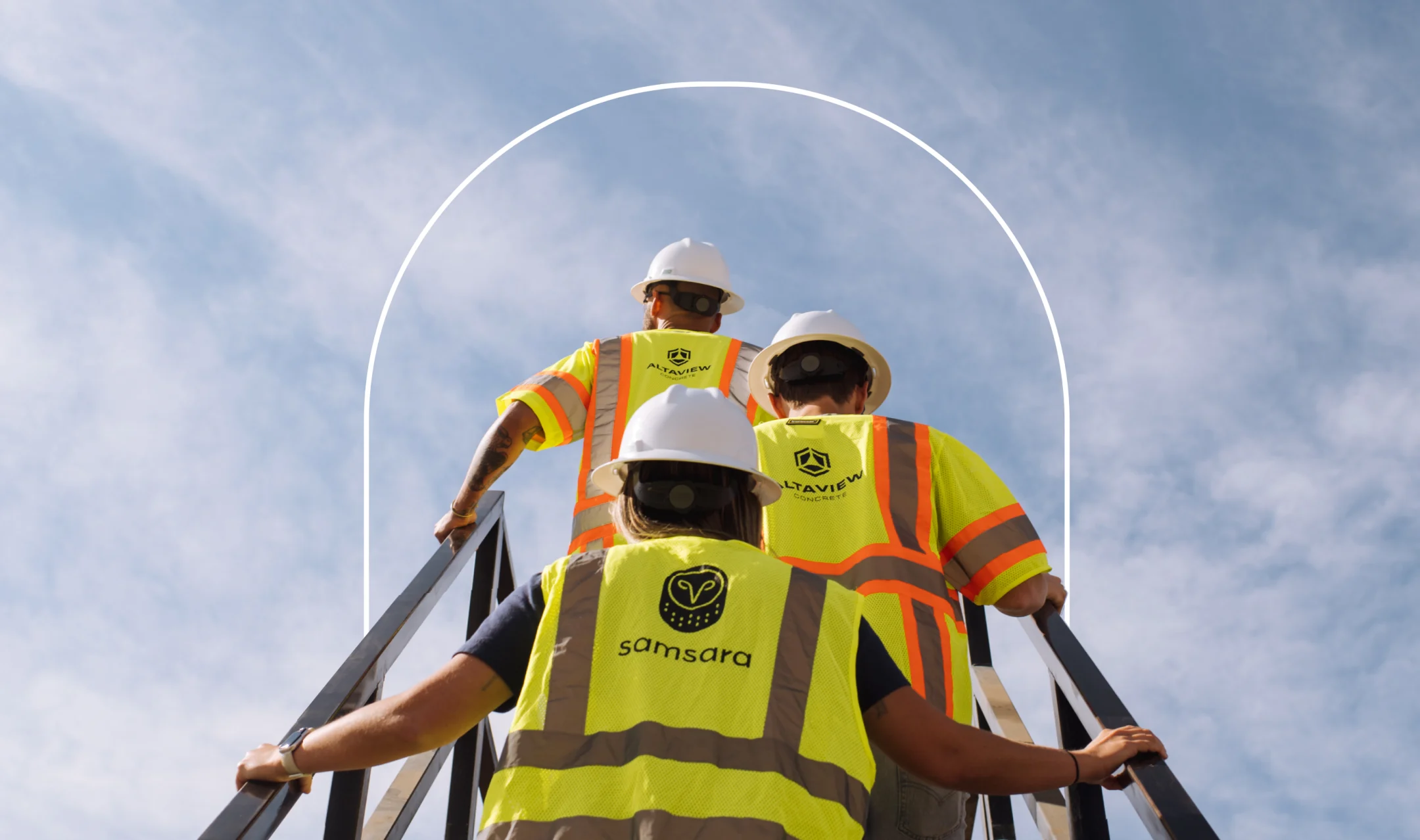
Make More Possible
Find ways to make more possible across your organization to empower your workers, increase efficiency, and reduce operational costs.
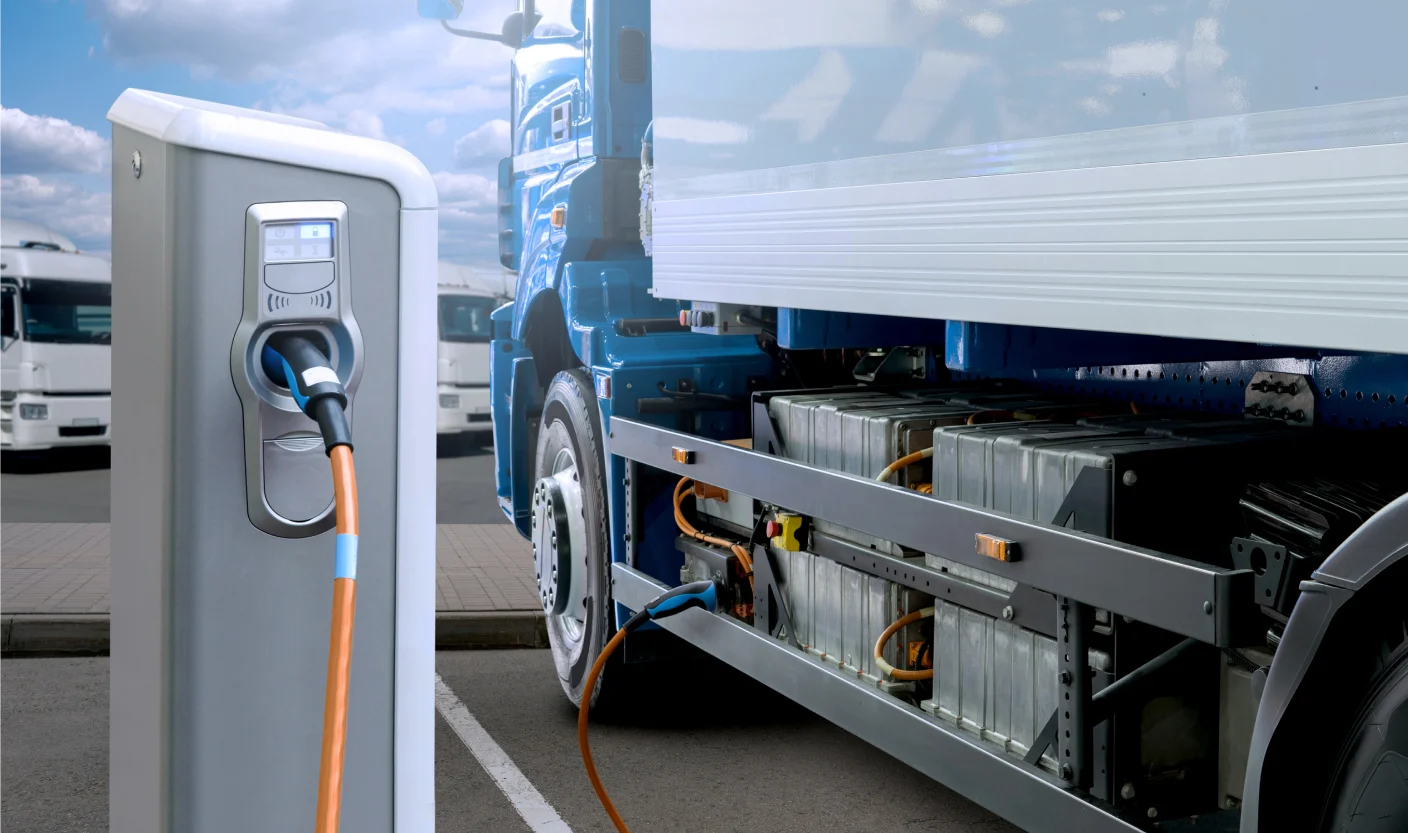
Build Your EV Fleet
Get the essentials on fleet electrification and better understand how an EV fleet can benefit your business.
Investor Relations
Samsara Ventures
Brand Assets
Featured News

Apply for the 2024 Connected Operations Awards

Samsara's 2023 Environmental, Social, and Governance (ESG) report
What is a Pre-Trip Inspection Checklist for Class A CDL
October 22, 2021
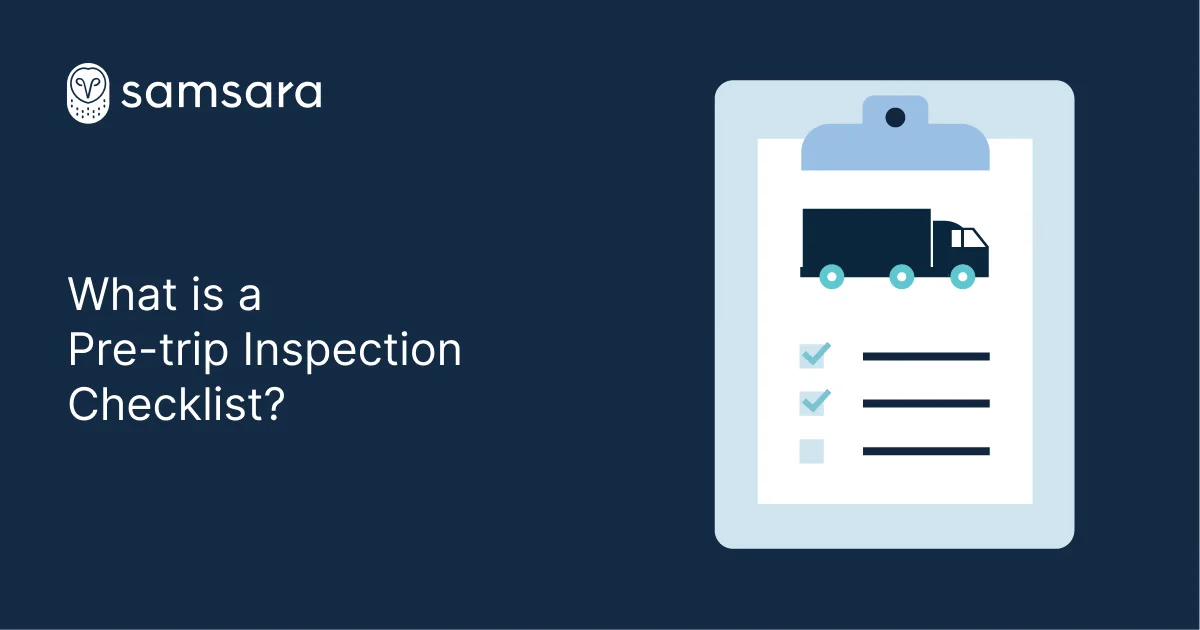
Get Started With Samsara
Key Takeaways
Drivers who have a class A commercial driver’s license (CDL) usually have to complete a pre-trip inspection on their non-passenger commercial vehicles. Having a pre-trip inspection checklist handy helps driver’s know what to expect when they pass their CDL examination and what parts of their vehicle the will need to inspect before heading out on the road.
What is a CDL pre-trip inspection checklist?
A pre-trip inspection checklist helps truck drivers remember all the major systems and parts to inspect before heading out on a route. Knowing how to complete a pre-trip vehicle inspection is an important part of trucking.
Pre-trip inspections for class A licensees
The class A commercial driver’s license (CDL) typically covers non-passenger commercial vehicles . These might include tractor-trailers, tankers, livestock carriers, flatbeds, and more.
The Department of Transportation (DOT) requires drivers to perform a pre-trip inspection before driving a commercial vehicle. Similar to Class B CDL holders, the actual daily pre-trip inspection takes about 15 minutes or less. Typically, the inspection includes the following, with some employers making their own variations.
Brakes and air system
Steering mechanism
Lights and reflectors
Tires, wheels, and rims
Windshield wipers
Rearview mirrors
Emergency equipment
Drivers complete a driver vehicle inspection report (DVIR) recording the completed inspection.
Class A CDL pre-trip inspection checklist
When getting a CDL, drivers need to pass a pre-trip inspection test. It’s more intensive than the inspection drivers perform daily. This pre-trip inspection checklist for a Class A CDL gives drivers an overview of performing an inspection. Check your state’s CDL manual for a complete list of inspection requirements.
Click here for a Class B pre-trip inspection list.
Engine compartment
Fluids - coolant, oil, and power steering : Reservoirs and tanks should not leak. Check hoses for splits or cuts and that they are securely mounted on both ends. Verify proper fluid levels with a dipstick.
Belts - alternator, pumps, compressor : All belts should be securely mounted without cracks or frays. Belt should have no more than 1/2" to 3/4" of play.
Hoses (passenger and driver’s sides) : All hoses, including power steering and coolant hose, should be secured on both ends. They should not have splits, cuts, or leaks.
Air compressor: May be difficult to see. Ensure it’s securely mounted, not broken, cracked or leaking.
Alternator : All wires are properly connected.
Water pump : All hoses are properly connected and not leaking.
Front of tractor/truck
Steering gearbox and hoses : No damage or leaks. Hose should be secured on both ends. They should not have splits, cuts, or leaks.
Steering shaft/steering column : Not bent or broken.
Pitman arm : All caste nuts and cotter pins are present and tight.
Drag link : Rubber is not split and properly greased.
Upper and lower control arms and tie rod : Tie rod should be secure, not cracked or bent.
Front suspension
Spring mounts/spring hanger : Not cracked or broken.
Leaf springs : None are cracked, broken, or shifted.
U-bolts : All accounted for.
Shock absorber : No visible leaks. Leaks will show at the point where the top and bottom of the shock meet. Rubber is not split or shows signs of dry rot.
Airbag : Check rubber for abrasions, cuts or audible leaks plus any missing mounting bolts.
Driver door and fuel area
Mirrors and bracket: Hardware attached properly. Mirror should be clean and not broken.
Door and hinges : Demonstrate door operations, latching properly, hinges intact. Door seals should not be torn or rotten.
Steps : Mounted properly and can hold weight.
Fuel tank: Not leaking; cap is tight with seal intact.
Rear of tractor/truck
Drive shaft : Not twisted, U-joints not broken and free of debris.
Exhaust system: Not loose, no sign of leaks (exterior soot).
Frame : Nothing broken or unauthorized welds.
Catwalk and steps : Properly mounted and clear of loose objects.
Mudflap : Secured, not missing or broken. At the right height.
Coupling area
Air connector: Secure on both ends, no abrasions, cuts, or audible leaks. Connectors should not drag or tangle.
Electric lines : Secure on both ends, no abrasions or cuts. Safety latches in place. Lines should not drag on the catwalk or tangle.
Glad hands : Seals should be in good condition with no cracks, signs of rotting, or leaking air.
Fifth wheel platform : Secure to frame, not cracked, bent or broken. No unauthorized or illegal welds.
Mounting bolts : No missing bolts and mounted tight.
Skid plate: Properly greased.
Release arm : Secure in fully locked position.
King pin : Mounted and secure. No cracks, bends, and breaks.
Locking jaw : Fully locked around the king pin.
Apron : Mounted and secure. No cracks, bends, and breaks.
Sliding 5th wheel locking pins : Pin must be in the fully locked position.
Brake system (both tractor and trailer)
Brake hose : Securely mounted on both ends. No splits, cuts, and not audibly leaking air.
Brake chamber : Not audibly leaking air.
Slack adjuster and push rod : When brakes are released and pulled by hand, the push rod should have no more than 1” of play. It should stay at a 90° angle to the brake chamber.
Brake drum : No bluing from excessive heat.
Brake pads/brake lining : Check for oil and debris on the lining. Minimum brake pad thickness is ¼.”
Wheel system (both tractor and trailer)
Wheel rims : No unauthorized or illegal welds.
Steer tires : Look for cuts, bulges, and abrasions on the tread and sidewalls. Tread depth should be a minimum of 4/32”. Tread should be evenly worn. Check inflation levels on tires with an air gauge, filled to manufacturer’s specifications.
Drive tires : Look for cuts, bulges, and abrasions on the tread and sidewalls. Tread depth should be a minimum of 2/32”. Tread should be evenly worn. Check inflation levels on tires with an air gauge, filled to manufacturer’s specifications.
Valve stem . Properly secured, metal cap in place. Not audibly leaking air.
Lug nuts : All accounted for. Check for rust or cracks.
Hub seal/axle seal : Should not be loose. No visible leaks.
Spacing : If equipped with duals, there must be proper spacing between the tires.
Frame and cross members : Secure, not cracked, bent or broken and none missing.
Header board : Secure and not excessively damaged. No holes or missing rivets.
Landing gear : Must be fully raised and the cradle handle secured. Not cracked, bent or broken.
Doors and hinges: Secured and should open, close and latch properly. Door seals have no separation, no rubber tubing sticking out.
Tandem release : Release handle and locking pins should be fully locked.
Trailers airbag : Check rubber for abrasions, cuts or audible leaks, plus any missing mounting bolts.
Trailer spring mounts/spring hanger : Not cracked or broken
Trailer leaf springs : None are cracked, broken, or shifted.
Trailer u-bolts : All accounted for.
Trailer shock absorber : No visible leaks. Leaks will show at the point where the top and bottom of the shock meet. Rubber is not split or shows signs of dry rot.
Torque arm/radius rod : Secure mounting, bushings intact.
Check all lights on the front, both sides of tractor, truck rear, both sides of trailer, and trailer rear. Turn on to ensure lights and reflectors are working.
Running lights : Walk around the truck and trailer to examine all.
High beams/low beams: Walk around the truck and trailer to examine all.
Turn signals : Signal both right turn and left turn. Walk around the truck and trailer to examine all.
Hazards/4-way flashers : Walk around the truck and trailer to examine all.
Brake lights : Ask the examiner to watch brake lights. Confirm they worked using the side mirror.
License plate lights : Walk around the truck and trailer to examine all.
Reflector tapes : Clean and not worn. Walk around the truck and trailer to examine all.
In-cab inspection and air brake test
Seat belt: No rips or frays and should adjust and latch properly.
Lighting indicators : See lights and reflectors section
Oil pressure indicator : Demonstrate normal operating range.
Water temperature gauge : Demonstrate normal operating range.
Air pressure gauges : Build to governor cut out.
Ammeter/voltmeter : Charging between 13 and 14 volts.
Mirrors : Secure, not cracked or broken. No obstructions and properly adjusted.
Windshield : No more than a 1” crack is permitted. Clean and free of debris.
Windshield wipers and washers: Turn on to show they are working properly.
Horns (city and air) : Show they are working properly.
Heater/defroster : Turn on to show they are working properly.
Safety/emergency equipment : Must have a fire extinguisher, three red reflective triangles and spare electrical fuses. Extinguisher must be fully charged and secured.
Steering wheel : Secured to steering column.
Foot pedals : Free of grease and debris. No obstructions.
Hydraulic brake check : Pump the brake pedal several times. Apply pressure to the pedal and hold for five seconds. The pedal should not move.
Air brake check : Air brake devices vary. Drivers must test three components of the air brake check correctly: applied pressure, warning lights and buzzers, and valve pop-outs.
Parking brake:
Trailer parking brake : Set the trailer brake, release the tractor brake. Put truck in low gear and tug.
Tractor parking brake : Set the tractor brake, release the trailer brake. Put truck in low gear and tug.
Service brake : Release both the tractor and trailer brakes. Drive 3 – 5 mph. Apply the service brake and come to a complete stop. Ensure steering does not pull to the left or right when applying the brakes.
Watch the video below to see how All Aboard America uses the Samsara Driver App to become nearly 100% paperless and save 30 minutes per trip, totaling 500 hours saved weekly.

Watch Video
- Northern Europe & Baltic Sea
COST of day trip to Moscow ??
By densol , February 26, 2012 in Northern Europe & Baltic Sea
Recommended Posts

We have just booked a cruise to the Baltics for next year. I am trying to find out the average cost for a day trip to Moscow from STP. I have searched several times, and whilst I have read reviews and reports about the trips etc - I cannot actually see any examples of the costs. I imagine its quite expensive - but we want to do it so I need to budget LOL !!
Any ballpark figures ? :D
Link to comment
Share on other sites.

We have just booked a cruise to the Baltics for next year. I am trying to find out the average cost for a day trip to Moscow from STP. I have searched several times, and whilst I have read reviews and reports about the trips etc - I cannot actually see any examples of the costs. I imagine its quite expensive - but we want to do it so I need to budget LOL !! Any ballpark figures ? Thanks
We did the Moscow trip through our cruise ship in late July 2008. Its cost was a little under $1000 pp. Now, that cost through this cruise line is a little over that $1000 pp cost. Now, most are using the high-speed rail connection versus the air flights as we did. I have seen some other numbers from other cruise lines and/or private firms that run $700-850.
Why cheaper or the differences? As cruise lines are pressured to keep their "sticker price" low, they need to make up some "margin" with ship tours, beverages, spa stuff, etc., to help cover their costs and gain some profit. Second, different tours provide various features. Our tour included going inside the famed and spectacular Kremlin Palace. Most Moscow tours don't feature that option and you cannot just walk up there and get in on your own. That Palace is where the Czars were crowned and all of the current/recent Russian leaders assumed their powers.
We could have saved a little if we had used a private tour to go to and visit Moscow, but, with my wife's pushing, we felt it was worth it to pay a little more, do it through the cruise line. If there had been any problems or mix-ups, it was the ship's duty to "make it right" and we would not have to worry.
If you have three days in St. Petersburg and/or have been there before, then the Moscow tour can work out very well. It's not cheap, but in my view, worth it!! Both are a few of my visuals from this super great city with such interesting history and dramatic architecture.
THANKS! Enjoy! Terry in Ohio
Did a June 7-19, 2011, Solstice cruise from Barcelona that had stops in Villefranche, ports near Pisa and Rome, Naples, Kotor, Venice and Dubrovnik . Enjoyed great weather and a wonderful trip. Dozens of wonderful visuals with key highlights, tips, comments, etc., on these postings. We are now at 66,454 views for this live/blog re-cap on our first sailing with Celebrity and much on wonderful Barcelona. Check these postings and added info at:
http://www.boards.cruisecritic.com/showthread.php?t=1426474
For details and visuals, etc., from our July 1-16, 2010, Norway Coast/Fjords/Arctic Circle cruise experience from Copenhagen on the Silver Cloud, check out this posting. This posting is now at 60,364 views.
http://www.boards.cruisecritic.com/showthread.php?t=1227923
One of the Kremlin Wall Towers in Moscow:
Walking on the famed Red Square of Moscow:
St. Basil's sits on Red Square and dates back to its 1555-61 construction on the orders of Ivan the Terrible (Ivan IV). It commemorates the capture of Kazan and Astrakhan and marks the geometric center of the city. This location has been the hub of its growth for Moscow since the 14th century. It was the tallest building in Moscow until the completion of the Ivan the Great Bell Tower in 1600. This church was near destroyed in the 1930’s when Stalin was in control.:
Here is a small sampling of the Kremlin Royal Treasures of the Czars: Eggs & Jewels insicde the famed Armory.:
Moscow’s subways are called the “People’s Palaces” with their marble coverings and unique designs for each of the different and many stations.:
This is the interior for Moscow's most historic church, Assumption Cathedral or the Cathedral of the Dormition, inside the Kremlin walls. It is the mother church of Muscovite Russia. The church stands on Cathedral Square and was built in 1475–1479 by the Italian architect Aristotele Fioravanti. It was erected on the spot of an older 14th century cathedral of the same name:
We did the day trip to Moscow with Alla-tour and were very pleased with our tour. Our guide whose English was great was a wealth of information and the day went very smoothly. I checked the web site and Alla's prices for 2012 range from $884 a person for two down to $542 a person for 6 with the 5% cruisecritic discount. So if you can get a group together the per person price goes down considerably. You can try to do this on the roll call section of cruisecritic.
We did not go to the Palace and as Terry says this is not included generally in tours. However, we did go to the Diamond Fund, an amazing display of crown jewels and jewelry in the Armoury building but not really part of the Armoury. I would think you could include this if you had a small group and really wanted to see it. It is quite small and does not accommodate a large group. You can google "diamond fund kremlin" to learn more.
Here are some of my pictures
Red Square with St. Basil’s at the far end
Kremlin Cathedral Square
Bolshoi Theatre
Treasures at the Armoury
200 ton Tsar Bell
Tomb of the Unknown Soldier

We did the day trip to Moscow with Alla-tour and were very pleased with our tour. Our guide whose English was great was a wealth of information and the day went very smoothly. I checked the web site and Alla's prices for 2012 range from $884 a person for two down to $542 a person for 6 with the 5% cruisecritic discount. So if you can get a group together the per person price goes down considerably. You can try to do this on the roll call section of cruisecritic. We did not go to the Palace and as Terry says this is not included generally in tours. However, we did go to the Diamond Fund, an amazing display of crown jewels and jewelry in the Armoury building but not really part of the Armoury. I would think you could include this if you had a small group and really wanted to see it. It is quite small and does not accommodate a large group. You can google "diamond fund kremlin" to learn more.
Well said, cadreamer! (nice photos, by the way).
We also used Alla. She is just a super person to work with and, if you get a group together, she will accomodate what YOU want to do!! You can check-out her Moscow tour at:
http://www.alla-tour.com/tours/1
As cadreamer suggests, go to your roll call on Cruise Critic & see if you can get a group together.
Terry, your pix, per usual, are awesome! Still envious! :)
Terry, your pix, per usual, are awesome! Still envious! :) jill
Appreciate, Jill, the kind comments! Envy is GOOD!!
Below are a few more visuals on Moscow that are more "interesting". Fascinating to having seen both cities, back-to-back. It really puts all of this unique Russian history and architecture in better perspective.
Did a June 7-19, 2011, Solstice cruise from Barcelona that had stops in Villefranche, ports near Pisa and Rome, Naples, Kotor, Venice and Dubrovnik . Enjoyed great weather and a wonderful trip. Dozens of wonderful visuals with key highlights, tips, comments, etc., on these postings. We are now at 67,001 views for this live/blog re-cap on our first sailing with Celebrity and much on wonderful Barcelona. Check these postings and added info at:
The famed KGB (Secret Police) Headquarters in Moscow where many entered and did not exit (alive) during the 1950’s and 1960’s:
Kremlin Treasures: Royal coaches:
Young Military Officers on the streets of Moscow with Soviet "High Hat".:
These are the series of smaller domes on the top of the Church of the Deposition of the Robe in the Kremlin Cathedral Square area.:
Inside the newly, more westernized GUM Department Store:
This topic is now archived and is closed to further replies.
- Welcome to Cruise Critic
- New Cruisers
- Cruise Lines “A – O”
- Cruise Lines “P – Z”
- River Cruising
- Cruise Critic News & Features
- Digital Photography & Cruise Technology
- Special Interest Cruising
- Cruise Discussion Topics
- UK Cruising
- Australia & New Zealand Cruisers
- Canadian Cruisers
- North American Homeports
- Ports of Call
- Cruise Conversations
Announcements
- New to Cruise Critic? Join our Community!
Write Your Own Amazing Review !

Click this gorgeous photo by member SUPERstar777 to share your review!
Features & News

LauraS · Started Friday at 07:21 PM
LauraS · Started Friday at 03:17 PM
LauraS · Started Thursday at 04:15 PM
LauraS · Started Thursday at 03:00 PM
LauraS · Started Thursday at 10:41 AM

- Existing user? Sign in OR Create an Account
- Find Your Roll Call
- Meet & Mingle
- Community Help Center
- All Activity
- Member Photo Albums
- Meet & Mingle Photos
- Favorite Cruise Memories
- Cruise Food Photos
- Cruise Ship Photos
- Ports of Call Photos
- Towel Animal Photos
- Amazing, Funny & Totally Awesome Cruise Photos
- Write a Review
- Live Cruise Reports
- Member Cruise Reviews
- Create New...

IMAGES
VIDEO
COMMENTS
Pre-purchase Car Inspection: Best Prices. Service Location. SELECT VEHICLE. Customer Ratings. ( 5,493) Included for free with this service. Book Online 24/7. Top-rated Mobile Mechanics. On-site Inspections.
With more than 1,700 locations, there's a Firestone Complete Auto Care near you . Schedule an appointment and come to see us for your next Complete Vehicle Inspection. You can even have your car inspected on a Sunday! Many of our stores are open in the evenings and on weekends for your convenience. Make an appointment to invest in your car's ...
Before you head out on a road trip, schedule your free Pre-Trip Safety Check. Our pros will inspect your vehicle and send you on your way. Nearest Store Change Store. 818 23rd St SE. Watertown, SD 57201 1128.1 mi.
Look for any cuts, damages or bulges. Maintain a tread depth of at least 4/32-inch. Measure tire pressure with a gauge (not a tire thumper) and maintain 90 - 100 psi. Tighten any loose lug nuts and report any missing ones. Listen for any air leaks. Look underneath andinside your trailer.
The average car safety, emissions, or VIN inspection costs less than $100, with most pre-purchase inspections costing between $150 and $250. Depending on local laws, many drivers must submit their vehicles to one or more inspections annually or biannually. Each set of inspection requirements also includes various exceptions and associated fees ...
A pre-trip inspection checklist is a list of vehicle items that truckers must thoroughly examine before starting a trip. It helps identify and address mechanical and maintenance issues early on and prevent unexpected delays, breakdowns and severe accidents. ... Save Time and Cost. Completing a routine pre-trip inspection takes just 15 minutes ...
Quick Steps. Check that your tires are inflated and the treads are deep enough for long travel. Inspect your exterior lights, horn, and windshield wiper blades. Make sure your air filter isn't clogged and that the AC and heat are working. Look at the belts in the engine for signs of cracking or glazing (shiny spots).
The age of the car. Inspections for new cars are likely to cost less within the first few years because a new car is unlikely to have developed any issues in that time. For example, Texas ...
The price depends on what state you live in and what's required. If you want a used car inspection before buying a car, you should expect to pay $100 to $350, depending on what systems you want to be checked. For the annual safety inspection, you can visit any shop that works with the state.
A pre-purchase car inspection is an important step in determining a used car's reliability. ... while Repair Pal pegs the estimated average pre-purchase inspection cost at $136-$173. And if you ...
3405 Rogers Road, Wake Forest, NC (47.63 mi) 24k Warranty. Rental Car. Open until 7:00 PM. (919) 694-7932. This shop is not accepting online appointments at this time. View All Locations. The average cost for a Pre-Purchase Car Inspection is between $132 and $200 but can vary from car to car. $132 - $167.
During a pre-trip inspection, drivers should inspect the steering components, suspension system, and wheel alignment to guarantee the vehicle's optimal performance. Specifically, drivers should examine the following components of the steering and suspension systems: Ball joints. Tie rod ends. Strut mounts or shock towers.
How do you know your vehicle is still in tip-top shape? You won't unless you conduct a thorough pre-trip inspection. The Federal Motor Carrier Safety Administration (FMCSA) requires pre-trip inspections every time you start a shift. If you're running late or in a hurry, it's tempting to skip the inspection or cut corners.
At your closest Firestone Complete Auto Care location! Stop by for a car inspection in the form of a free Courtesy Check as soon as you notice something that's "off" about your car. After all, you rely on your car day in and day out. Safety and reliability are two things you don't want to risk. Firestone auto technicians will get to the bottom ...
Pre-Trip Vehicle Inspection. The open road is calling! But, before you jet out for a road trip, it's important to ensure your vehicle is in good working condition to handle the long journey ahead. In this #cartalk video blog, Joe Hyde, Director of Automotive Technology, walks us through the important car systems and components to double-check ...
What is a pre-trip inspection? A pre-trip inspection includes checking over the tractor and trailer a truck driver will be operating. A pre-trip should be completed before the operation of a vehicle: At the beginning of a driver's shift. Any time a new trailer is picked up. After a 10-hour break. A thorough inspection usually takes anywhere ...
Let us do a complimentary car check for you. Our technicians will check your vehicle for free, and if we find an issue, we will always consult you before we make any adjustments or repairs. Come in a week before your trip, just in case any repairs are needed. We'll run a test on all safety components and major parts of your vehicle>.
Drivers complete a driver vehicle inspection report (DVIR) recording the completed inspection. Class A CDL pre-trip inspection checklist. When getting a CDL, drivers need to pass a pre-trip inspection test. It's more intensive than the inspection drivers perform daily. This pre-trip inspection checklist for a Class A CDL gives drivers an ...
Midas Closer Look Vehicle Check™. Safe driving is all about staying aware of what's up ahead. With our Closer Look Vehicle Check, our Midas techs can perform a comprehensive visual inspection of your car's major components and systems, every time you bring it in. We'll peek inside, outside, under the hood and under the vehicle, and let ...
Specialties: This Meineke Car Care Center in Moscow, Idaho has qualified auto repair mechanics ready to serve you with a state inspection, oil change, tire repair or installation, wheel alignment, brake repair or replacement, muffler and exhaust repair, ac repair, radiator repair, or just about any other auto repair service you can think of. Call or book an appointment today for an excellent ...
The government has proposed eliminating mandatory inspections for new cars, a formality that experts say should have been eliminated long ago.
We have just booked a cruise to the Baltics for next year. I am trying to find out the average cost for a day trip to Moscow from STP. I have searched several times, and whilst I have read reviews and reports about the trips etc - I cannot actually see any examples of the costs. I imagine its qui...
which must be kept on-board the vehicle] - Outbound trip: - Inbound trip: Identification number of routes to be used (if prescribed) - Outbound trip: - Inbound trip: Inspection and signature/seal by control authority of the departure country - Outbound trip: date and place - Inbound trip: date and place